It seems we can’t find what you’re looking for. Perhaps searching can help.
Sign Up for newsletter!
Subscribe to get the latest eBook!
Hotline






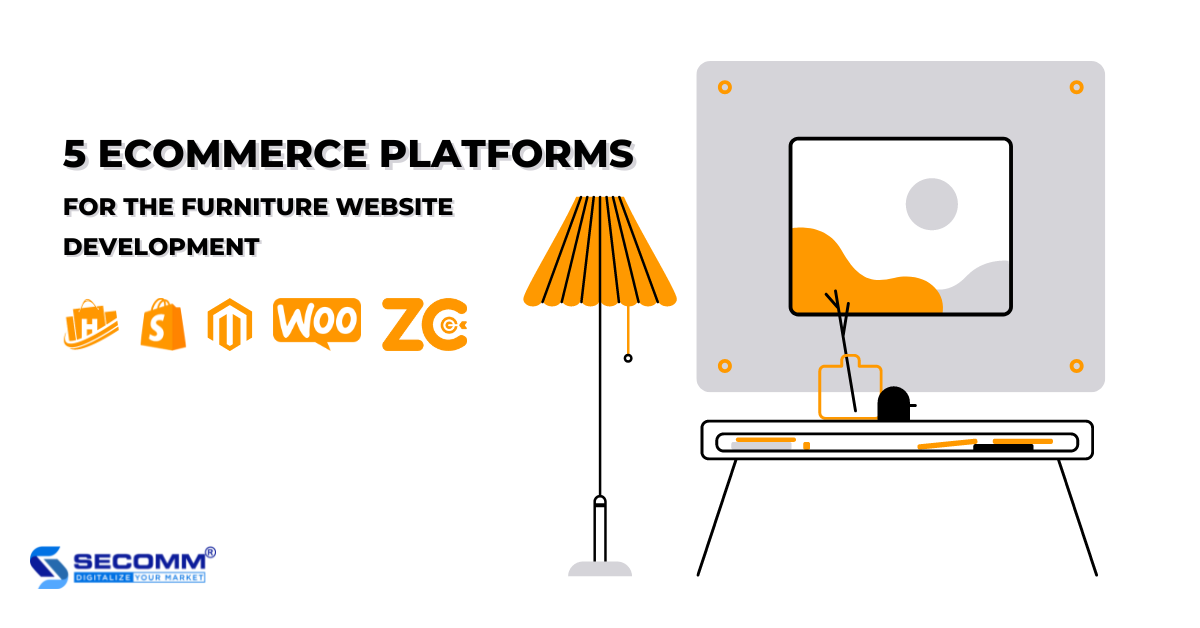
eCommerce is currently developing into a fresh and promising sales channel for furniture companies in addition to the traditional sales channel. Businesses must work hard to sustain and achieve breakthrough growth through eCommerce platforms, though.
As a result, numerous furniture companies started developing online furniture business websites and found surprising success, such Sieu Thi Noi That va Trang Tri Baya, Nha Xinh, Cozy, or Noi Phat Hoa Phat.
These websites’ success can be attributed to their early selection of an adequate and suitable eCommerce platform. Which platforms are appropriate for the furniture industry, then?
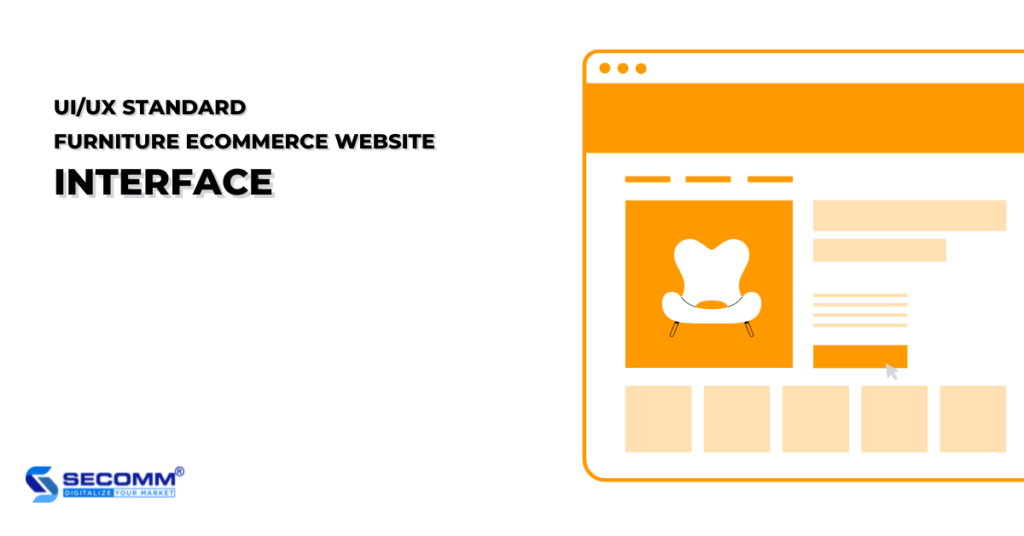
The first criterion businesses set when developing an eCommerce website is a standard UI / UX interface, friendly to users who enjoy shopping for furniture online and other home goods to increase customer interaction.
Similar to eCommerce websites in other sectors like fashion, electronics, etc., websites in the furniture sector must feature stunning and high-quality photographs and videos.
This makes it simpler for companies to communicate product information to customers, especially with banner advertisements that have an easy-to-use interface and a pleasing style that will pique shoppers’ interests.
Businesses also need to consider other concerns including call-to-action button placement, cross-device compatibility, and layout designs that display a range of product designs from the navigation bar to page-by-page details.
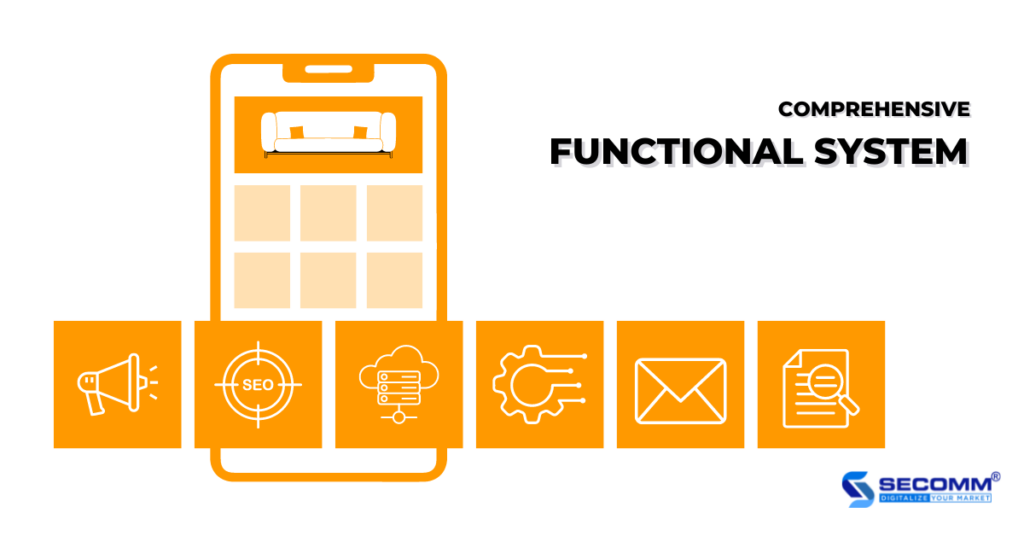
Furniture firms need a functional system from basic to advanced to fully meet consumers’ buying expectations and maximize the user experience. This system should include:
Businesses also need to develop some additional specialized features to address the furniture industry’s “own challenge,” such as:
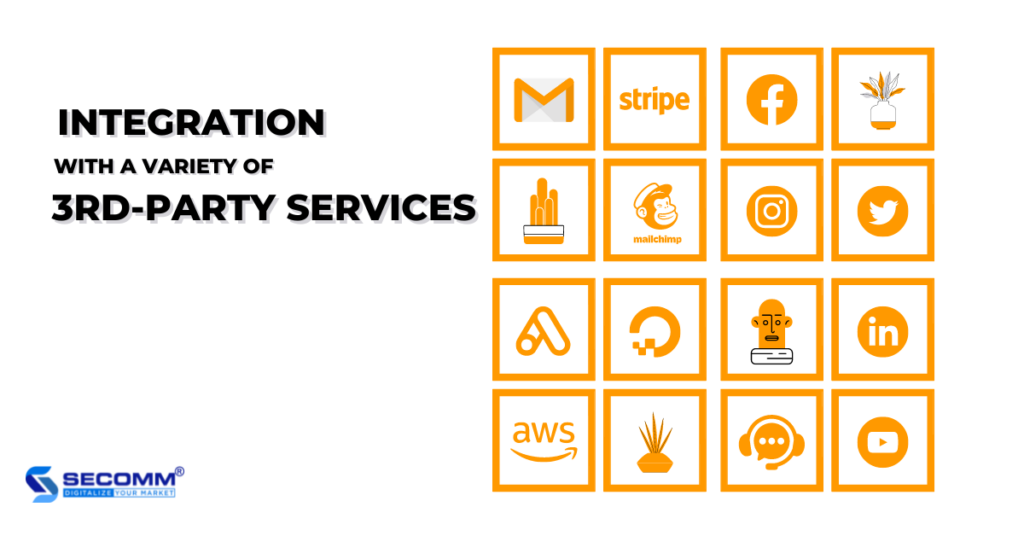
Furniture businesses frequently integrate a range of payment options, shipping services, management software, and business analysis tools to optimize eCommerce business systems in order to provide customers with a comprehensive shopping experience.
Some popular payment methods businesses can integrate on the website to diversify payment methods to help customers have many choices such as card payment; eWallet; payment gateways.
Businesses might take into consideration software like ERP (SAP, Salesforce, Oracle), among others, when integrating back-office administration and operation software.
Finally, incorporating BI tools like Tableau, Looker, etc. will aid in the long-term analysis of business plans.
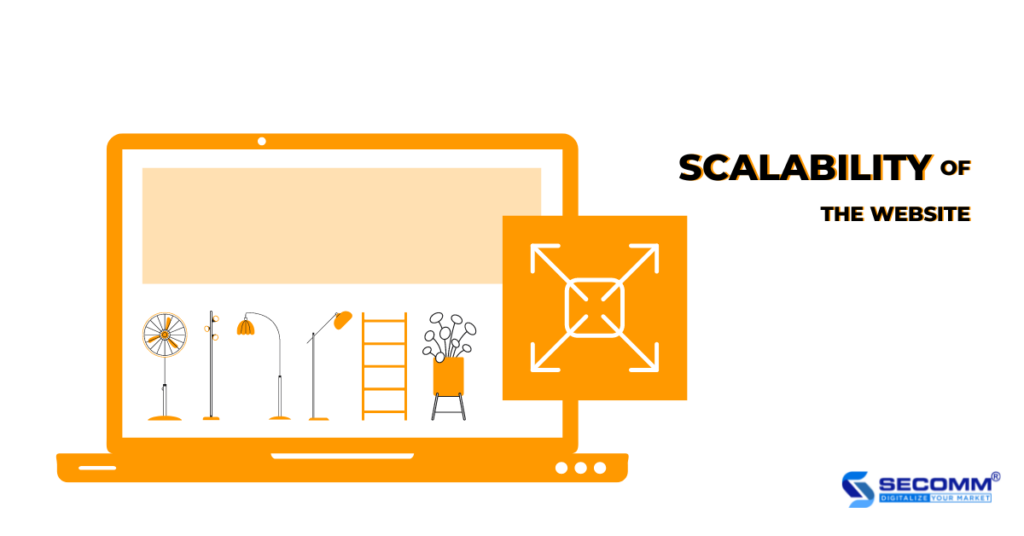
Businesses that are just starting to use eCommerce won’t concentrate on the website’s scalability in the future because platforms that provide this feature are sometimes hard to find. But tactically, spending money on a platform that facilitates this function will provide organizations an advantage over rivals in the market.
These aid furniture companies in making necessary adjustments, creating new features, and expanding their online systems to support several stores, languages, and currencies in the future.
Haravan was founded in 2014 and is a very popular and popular eCommerce deployment platform in the Vietnam market with a variety of solutions for businesses and individual sellers.
Pros:
Cons:
=> Rating: 2/4
Haravan is suitable for start-up furniture businesses or SMEs (small and medium-sized enterprises) with operations mainly in Vietnam.
Shopify is a popular SaaS platform in the world that provides a variety of solutions for businesses of all sizes to successfully build eCommerce websites.
Pros:
Cons:
=> Rating: 2/4
Shopify is considered suitable for start-ups or SMEs with global operations.
ZielCommerce is an eCommerce platform with ready-made solutions specialized for the furniture industry.
Pros:
Cons:
=> Rating: 3/4
ZielCommerce will be the optimal choice for B2B, and B2C furniture businesses to deploy eCommerce websites or build mobile apps. However, this platform is not really popular in the Vietnamese market but is especially favored by foreign furniture retailers such as Frampo, Zeyka, etc.
WooCommerce is a free WordPress plugin that allows businesses to transform a regular WordPress website into a professional eCommerce website with full features and easy customization with just a few simple steps.
Pros:
Cons:
=> Rating: 3/4
WooCommerce will be suitable for furniture businesses who are familiar with the WordPress platform and want to develop an eCommerce system.
Magento is a popular open-source commerce platform in the field of eCommerce, with nearly 200,000 websites in use. Currently, Magento has 2 versions: Magento Open Source (free), and Magento Commerce (paid).
Pros:
Cons:
=> Rating: 4/4
Magento is appropriate for a range of furniture business types, including B2B, B2C, and B2B2C, as well as for various business sizes, including start-ups, SMEs, and major companies. However, large organizations use Magento because it is frequently relatively expensive to deploy.
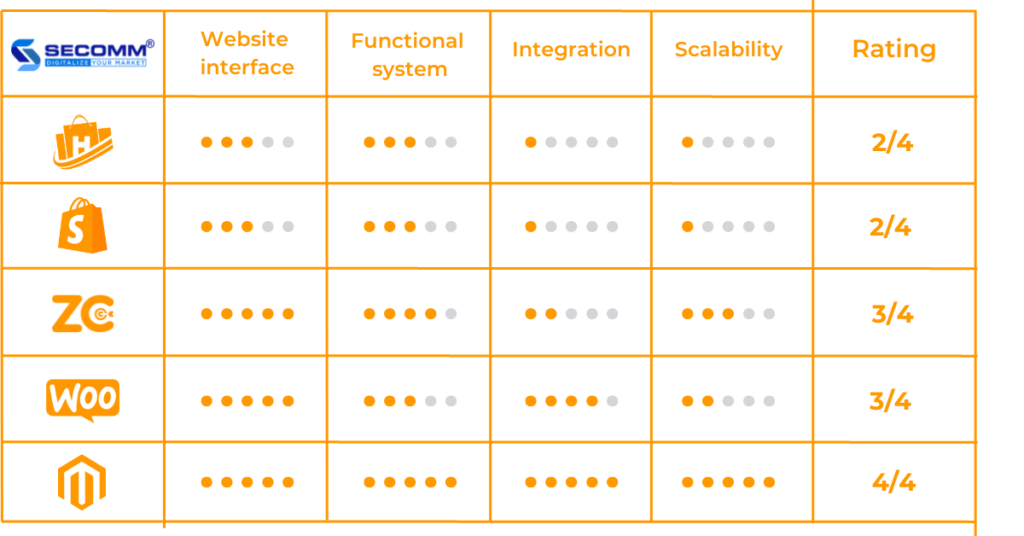
Choosing the right platform is an extremely important first step when building an interior eCommerce website. Choosing the right eCommerce platform will help businesses save budget and time to build a website while increasing competitive advantage and sustainable growth. On the contrary, when choosing the wrong platform, it will cost businesses a lot of time and budget to deploy and switch platforms many times. Therefore, businesses need to consider the goals and problems in the current model to be able to choose the most suitable platform.
With many years of experience in successfully implementing eCommerce for many customers in many countries, SECOMM specializes in providing consulting services with comprehensive and professional eCommerce implementation solutions.
Contact SECOMM today for free support and advice.
 2
2
 4,965
4,965
 0
0
 1
1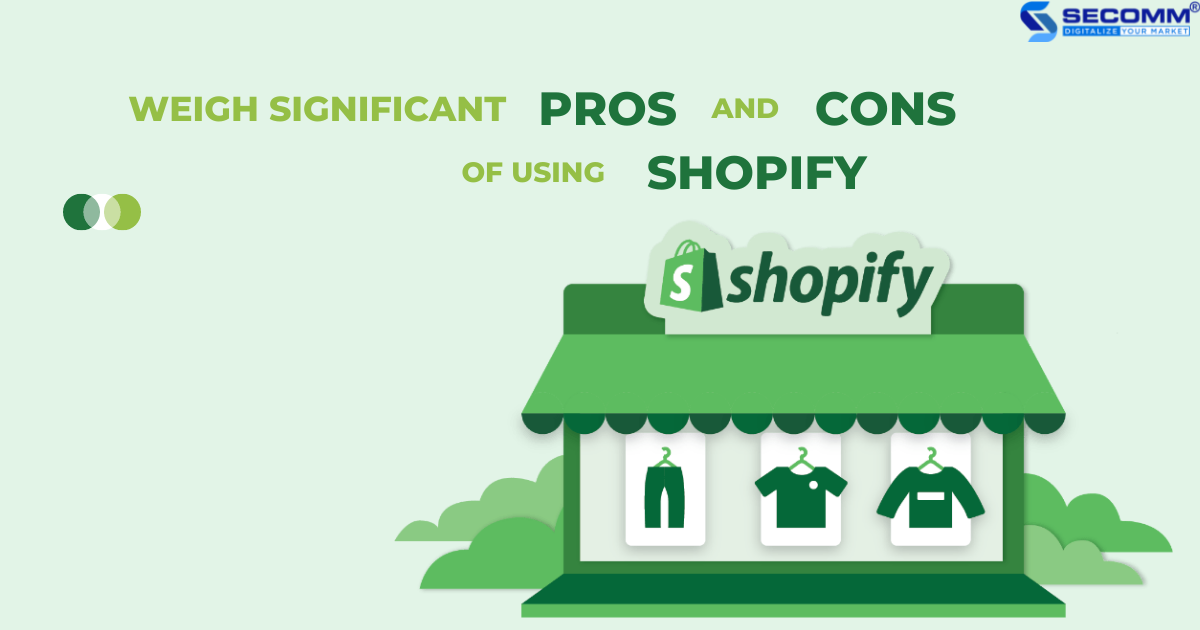
Today, for businesses of all sizes, eCommerce websites play an essential role in reaching and buying products for a wide pool of potential customers on the Internet.
Thus, choosing the right platform to build an eCommerce website is incredibly important. A good eCommerce platform will make it easy for businesses to provide Omnichannel experiences, personalize customer experiences, offer a variety of services, products, and more to increase conversions and drive online sales.
Some commonly mentioned platforms for building eCommerce websites are Magento, Woocommerce, Bigcommerce, etc. Definitely, each business will have its considerations, but one platform that always appears as a top choice is Shopify. In spite of the fact that the platform is highly rated, businesses should still weigh the pros and cons of this platform before making a final decision.
As a result, SECOMM has prepared this review, helping businesses understand what Shopify is, how it works, implementation costs, and especially the pros and cons of using this platform to build a comprehensive eCommerce website.
Before becoming one of the most popular eCommerce platforms globally, Shopify started as an online ski store called Snowdevil in 2004. Later, the company transformed into an eCommerce platform named Jaded Pixel.
In 2006, It was officially founded in Ottawa by young programmers Tobias Lutke, Daniel Weinand, and Scott Lake. Since then, the platform has gradually affirmed its position as a reliable and fastest-growing eCommerce platform in the last two years when most companies faced many difficulties because of the Covid-19 pandemic.
Up to now, the number of Shopify users has increased significantly. As reported by StoreLeads, there are currently about 2 million websites using the platform to build and develop online businesses. In the second quarter of 2022, the number of newly opened stores reached 150,928, an increase of 10.8% compared to the same period in 2021. In Vietnam alone, there are about 2,000 websites using the platform in operation, up 9.8% in the second quarter of 2022 over the same period in 2021.
Total revenue in the second quarter of 2022 reached $1.3 billion, up 16% over the same period in 2021, corresponding to a compound annual growth rate for three consecutive years of 53%. Gross profit in the second quarter of 2022 increased by 6% to $655.6 million compared to $620.9 million in the second quarter of 2021 (According to Shopify’s report).
While it is one of the most popular and user-friendly eCommerce platforms available today, businesses still need to determine if this is what they need to expand their business, all the advantages and disadvantages of the platform, mostly the cost issue.
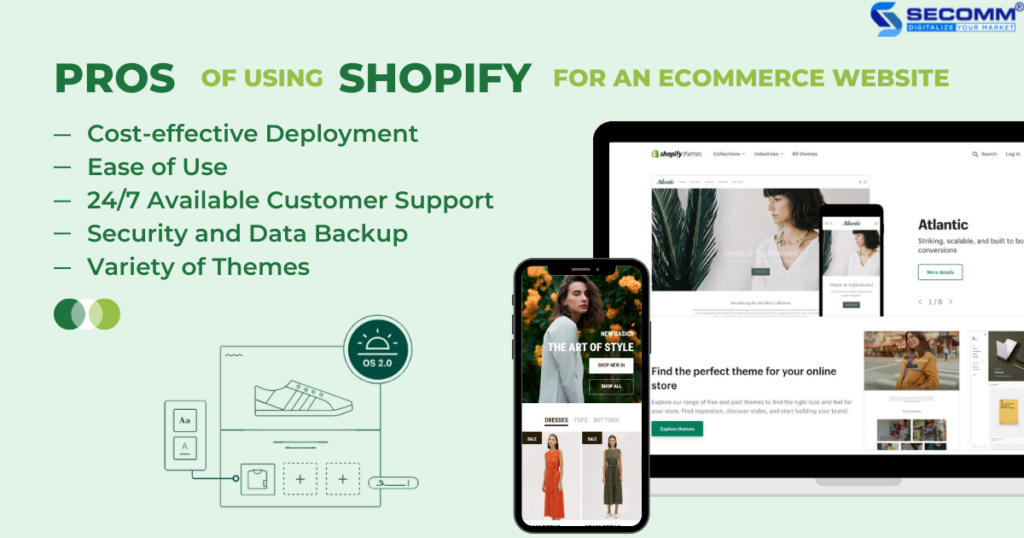
For a start, businesses can enjoy a 14-day free trial without a credit card requirement. When the free trial ends, businesses are encouraged to opt for one of the solution packages with suitable features and appealing promotions.
Packages | Price | Main Features | Unique Features | Ideally suited for |
Starter |
| Create product pages and get shareable links with product information, then send those links to customers via social platforms or message apps. | Merchants that sell on social platforms or message apps with no website in demand | |
Lite |
| – Shopify Buy Button. – Invoicing. | Merchants that sell on an existing website or social platforms. | |
Basic |
| – Customizable website editor. – Website hosting and free TSL certificate. – Unlimited number of products. – Analytical reports – Localization: currency conversion, website translation, regional domains. – Inventory Management. – Shopify POS. – Shopify Email. -Shopify Payment. – 24/7 Customer service. | – 2 staff accounts. – 4 inventory locations. – Basic reports. | Businesses who have just entered or intend to enter the eCommerce world and look for comprehensive eCommerce solutions. |
Shopify |
| – 5 staff accounts. – 5 inventory locations. – Standard reports. | Steadily growing eCommerce businesses. | |
Advanced |
| -15 staff accounts. -8 inventory locations. – Advanced reports. – Automation tools. | Large-scale businesses that sell internationally | |
Plus | Từ $2000/month. However, businesses can contact Shopify for a custom estimate. | – 9 expansion websites. – Up to 100 themes. – Exclusive Merchant Success Program, Shopify Plus Academy, Shopify Plus Partner , Shopify Plus Community on Facebook | Enterprise-level businesses that manage and operate multiple eCommerce websites. |
Table list of price, and features of Shopify solution packages.
First and foremost, because it is a SaaS platform, the cost to get started is usually quite low. Despite the fact that businesses must pay monthly fees, transaction fees, theme fees, and extension fees, Shopify is still significantly less expensive than open-source platforms such as Magento, WooCommerce, and others.
The development of an open-source platform necessitates the assistance of experienced programmers and takes a long time to deploy, whereas the SaaS platform is the inverse. That is the reason why starting with a SaaS platform, specifically, Shopify, will save businesses both time and expense.
Another cost highlight is that SaaS platforms, in general, and Shopify in particular, require an ongoing monthly fee rather than a one-time purchase fee to use the platform. This reduces the risk of businesses investing too much money in the platform but not meeting their expectations during the implementation process.
Furthermore, the Shopify platform is appropriate for different-sized businesses in the market. The Starter, Lite, and Basic packages are appropriate for SME businesses engaged in eCommerce. Shopify, Advanced, and Plus packages are ideal for large-scale businesses that require advanced features to run an effective eCommerce website.
The only way to adapt to the ever-changing market and quickly reach a wide pool of potential customers is for businesses to deploy eCommerce websites as soon as possible to avoid being left behind in the competition of the digital transformation race. One of the important factors when building an eCommerce website is choosing the right platform.
In particular, the top goal to consider when choosing an eCommerce platform is the ease of use. If a platform takes users too long to learn and implement or makes users dependent on external support, then the platform is not easy to use
Shopify has an easy-to-use interface for users with little programming knowledge. Moreover, Shopify is a SaaS eCommerce platform with a pre-designed system that offers hosting, interface, features, and technology infrastructure maintenance, allowing businesses to easily build and operate the website system with just drag and drop without worrying about technical issues.
Simple steps to get started with the eCommerce website implementation with Shopify:
This is one of the most crucial factors influencing users’ decision to use Shopify. Difficulties and obstacles are inevitable when building an eCommerce website, so Shopify has assembled a reliable and trusted team to assist users.
As a result, if your business requires assistance, assistance is available 24/7. Businesses can reach Shopify via email, chat, and a hotline worldwide. What’s more, users can access community forums and useful documents for developing eCommerce websites on this platform, mostly through the Shopify Support Center.
The Shopify platform runs on PCI (Peripheral Component Interconnect) compliant servers, allowing merchants to accept credit card payments. Secure Sockets Layer (SSL) encryption is enabled on all Shopify websites to secure visitor data, while a backup system allows businesses to store and save data regularly by exporting data to a CSV file.
As an outcome, the platform encourages the addition of an advanced backup solution from the Shopify Store, such as the Rewind app, as it is seen as a lifesaver if users accidentally delete content such as products or images or a video demonstration. To keep your eCommerce website secure, simply back up your data on a regular basis and use a strong enough admin password.
The interface is the appearance of a business’s eCommerce website. The more appealing the website interface, the more likely it is to retain customers, attract more visitors, as well as generate more conversions.
Shopify understands the importance of a website interface, so it has made a host of available themes, both free and paid, suitable for a wide range of businesses and fields, making it simple for businesses to choose from.
The free Shopify themes are ideal for startups, small and medium-sized businesses, and individuals. Businesses can customize their eCommerce website according to their needs and brand features by using features such as responsive web design, product filters, and product color display templates.
However, free themes have some downsides, including a limited number of themes, limited design, and a lack of advanced and specific features, which makes website customization difficult.
In fact, free themes are great for launching an eCommerce website. Premium interfaces, also known as paid themes, will be more suitable for large-scale businesses or businesses on the rise, with an average cost of around $140-$180/theme.
Shopify’s paid themes include advanced integration features such as live chat support, newsletter popups, upsell features, faster page loading, and much more. Thereby, businesses can run an eCommerce website automatedly and smoothly.
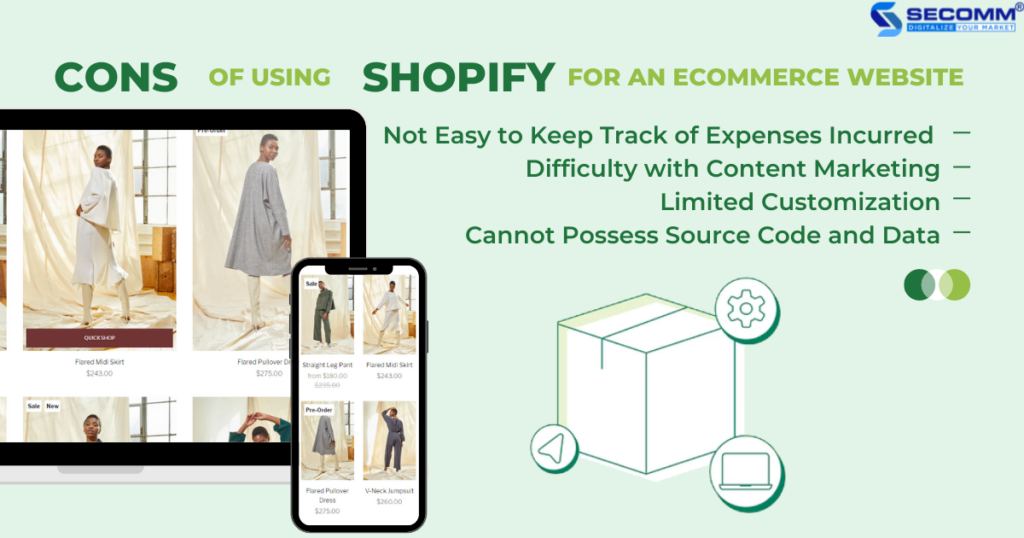
The cost of using Shopify, besides the notable pluses, the platform has a small but enough minus to make some businesses hesitate to start.
In addition to the monthly fee for using the enterprise platform, businesses must pay for other costs such as themes, applications, extensions, marketing features, sales, and SEO on a monthly basis with no long-term possession.
For example, to use the Free Shipping & Hello Bar application that offers free gifts, free shipping, or other types of promotions, users will buy for $8.95/month, which means ongoing monthly in regards to other expenses, businesses will pay an additional $8.95 for this app until it is no longer used.
When there are small expenses incurred each month, it is difficult to control cash flow for large-scale businesses that have to manage and operate many websites at the same time.
Meanwhile, open-source platforms require a one-time purchase fee rather than an ongoing monthly fee. Although the features are not yet available and take a long time to program, businesses can possess those features for eCommerce websites in the long run. Thereby, it makes cash flow management more convenient and effective.
It is a great way to promote your eCommerce website. Users can use Shopify to blog and optimize SEO, drive free traffic, and improve brand positioning.
However, this blogging feature on Shopify is not as user-friendly as WordPress. Some of the criteria Shopify can improve regarding blogging and content writing include:
This will be a barrier for businesses when using Shopify to promote eCommerce websites by optimizing SEO if the content is a core element of the business’s marketing strategy.
Another limitation of Shopify is that the platform’s interface is customized using the Shopify Liquid setup. Meanwhile, many website developers are already familiar with the PHP programming language to customize the themes and templates of the website, it is a common technique used by WordPress.
Therefore, users who do not have much experience in programming will face many obstacles when using Shopify’s tools to customize the interface of the eCommerce website.
However, businesses of all sizes can still use other useful Shopify features like Shopify Themes, Shopify App Store, Shopify Blog, 24/7 support team, and more to set up an eCommerce website quickly and effortlessly.
Because the entire business’s website system is hosted on Shopify’s server, the ownership and control of the website source code will belong to Shopify, not the business. Similar to other SaaS platforms such as BigCommerce, Squarespace, Wix… Shopify has a Lock-in feature, which means that when converting a website from one platform to another, businesses will no longer be able to use the old website source code and have to rebuild from scratch on a new platform.
Similar to the source code, business data is also stored on Shopify’s servers, so data ownership and control are quite limited. This makes it difficult for businesses to connect data among internal departments or users’ personalization, etc. Especially when switching platforms, data loss or misalignment is often unavoidable.
Shopify will not assist in the event that businesses stop using the platform for any reason. The only asset businesses can keep and take away is a CSV report containing website information.
Hence, before starting an eCommerce website on the Shopify platform, businesses need to carefully consider the benefits and disadvantages of stopping using it to conclude whether Shopify is the best fit for business in the long run.
Going by this article, Shopify is one of the eCommerce platforms that many businesses would love to choose when deploying an eCommerce website. However, besides the outstanding advantages, there are still certain downsides, so businesses need to carefully consider and compare with other platforms before starting out.
With many years of experience in implementing eCommerce in many countries, SECOMM provides free consulting services with professional eCommerce solutions.
Contact us today for free support and advice!
 2
2
 4,877
4,877
 0
0
 1
1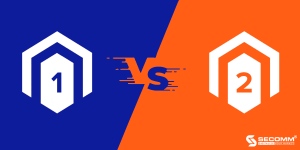
Magento is a specialized open-source platform for creating the most popular eCommerce websites today.
Currently, it supports two versions: Magento 1 and Magento 2. Some websites use M1 platform, such as CellphoneS, and Bach Long Mobile (Magento Open Source 1.9). Websites using M2 such as Di Dong Viet, and Kidsplaza (Magento Open Source 2.3).
So what is the difference between the two versions, and why have businesses not upgraded their websites to M2?
M2 uses newer technologies than M1, resulting in more diverse performance, user experience, and functionality.
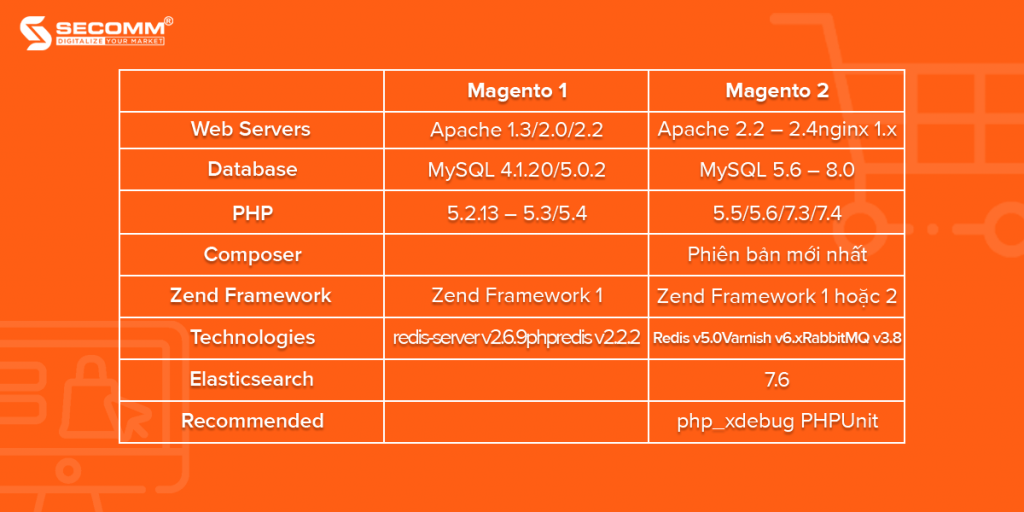
Both platforms support a wide range of third-party extensions. However, many utilities on M1 will frequently repeat a piece of code, causing conflicts for the website’s functional system, and requiring a significant amount of time to manually fix it. Meanwhile, Magento 2 has supported a plugin that allows code to overlap, assisting in the issue’s faster and more effective resolution.
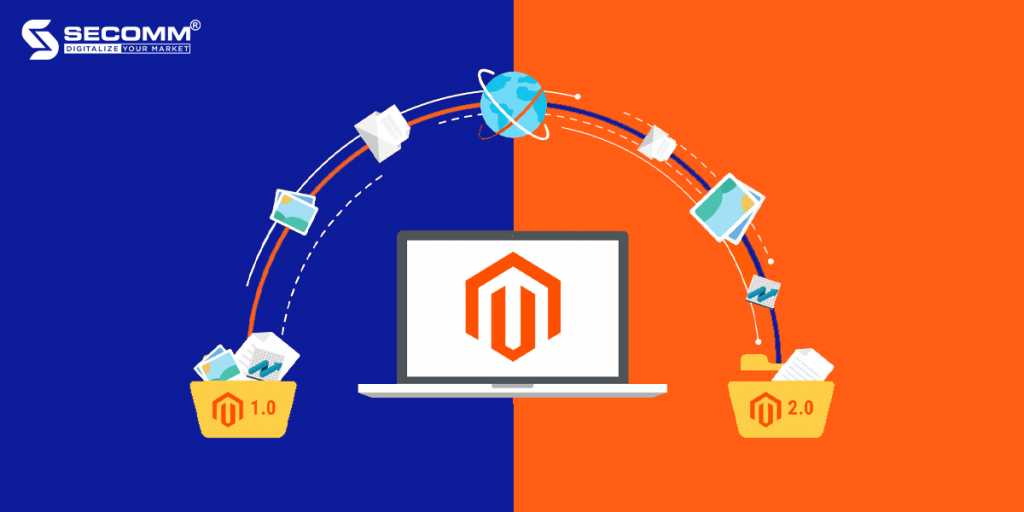
At the same time, M2 support utilities frequently use new technologies (HTML5, CSS3, Requirejs) at lower prices. Compared to M1, this makes it easier for developers to customize, upgrade, and build new functionality for the website.
Magento 1 is frequently criticized for having a messy admin interface that takes a long time to adapt. In contrast, Magento 2 is more user-friendly for admin accounts because:
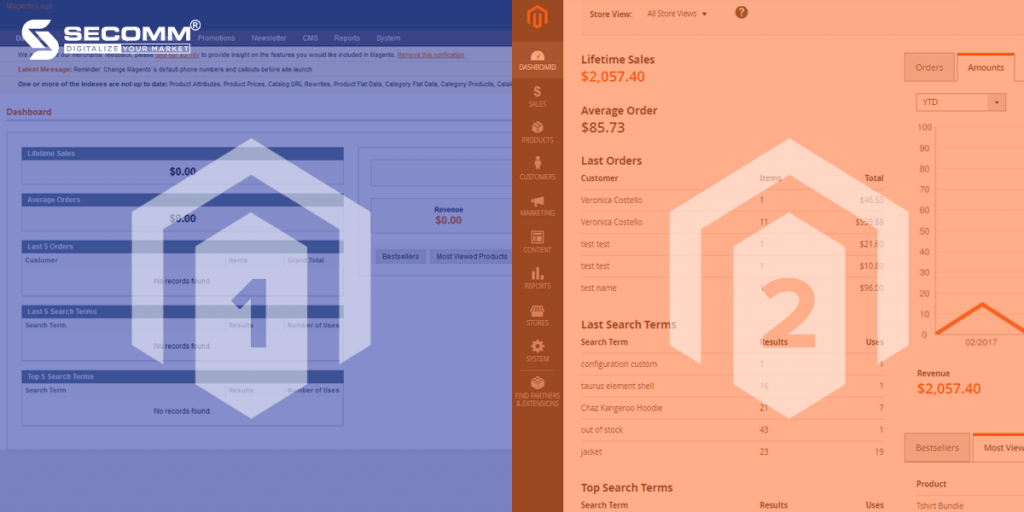
Magento has long been known for its SEO capabilities, but developers can improve SEO even better with Magento 2:
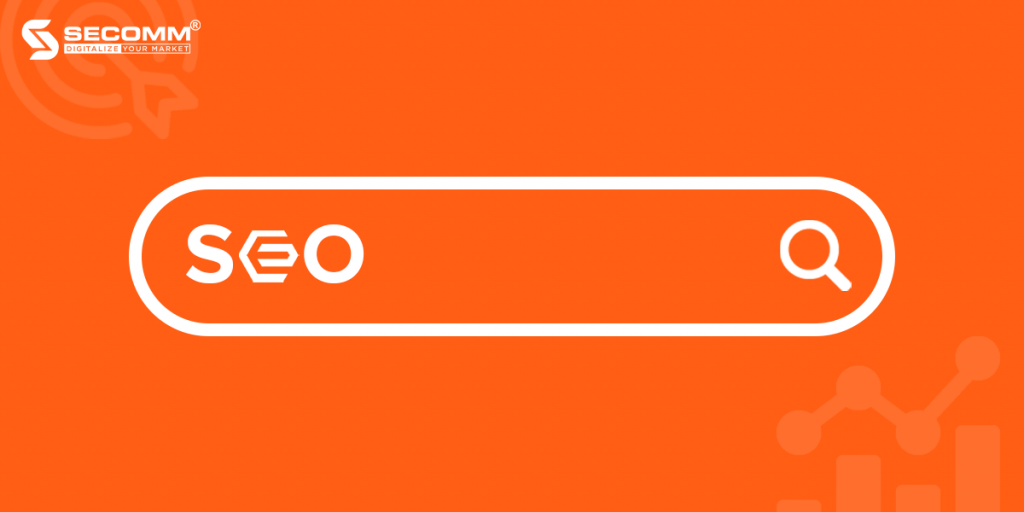
Since June 2020, Magento has stopped updating and releasing security patches and fixes for M1. Therefore, M1 websites easily become a target for cyber attacks.
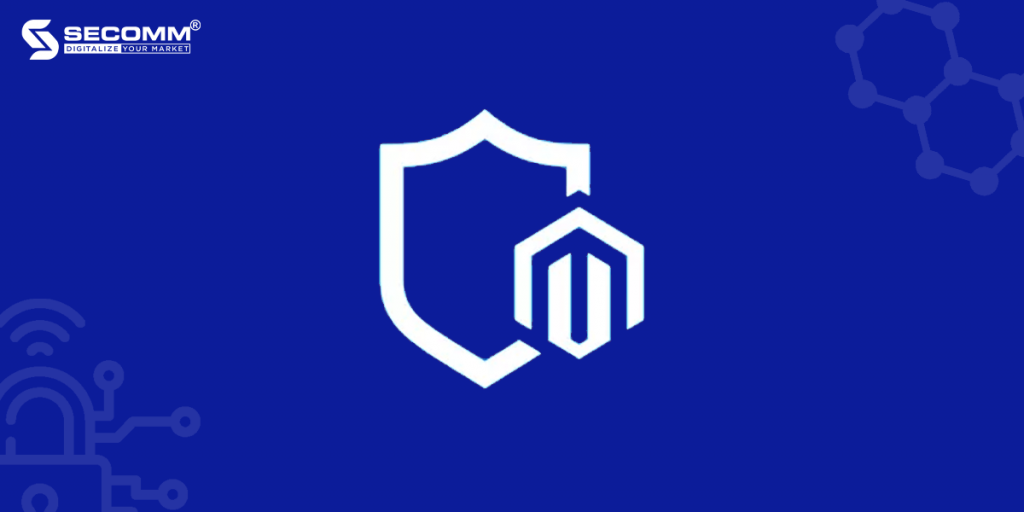
Meanwhile, the publisher continuously updates M2 to increase the system’s security. For example
M1 continues to meet enterprise eCommerce systems’ interface, functional systems, and management system requirements. As a result, businesses continue to use M1 rather than upgrading to M2. At the same time, the Magento technical community continues to support the utilities for M1 enthusiastically.
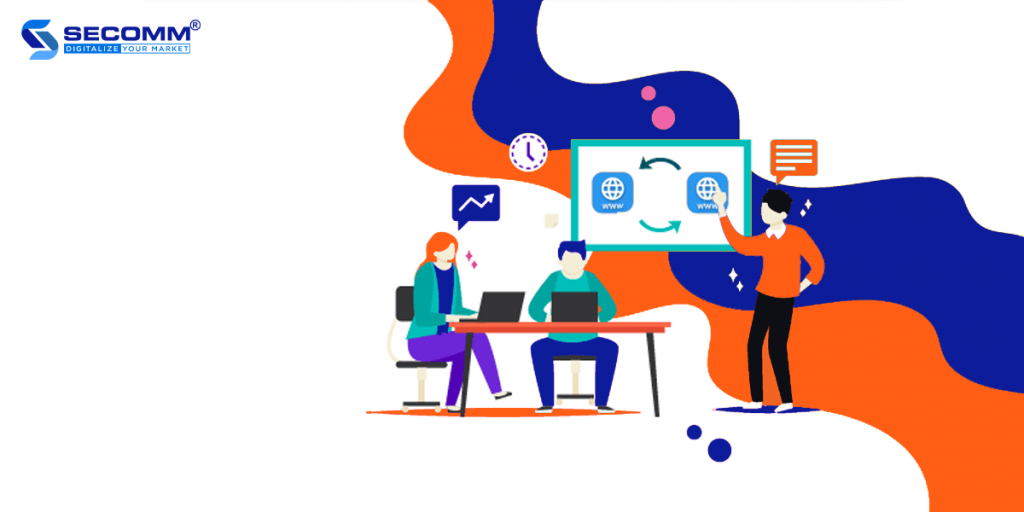
Although Magento 2 provides many improved utilities, its technologies are still relatively new for many companies, particularly those in countries that have lagged behind eCommerce market growth.
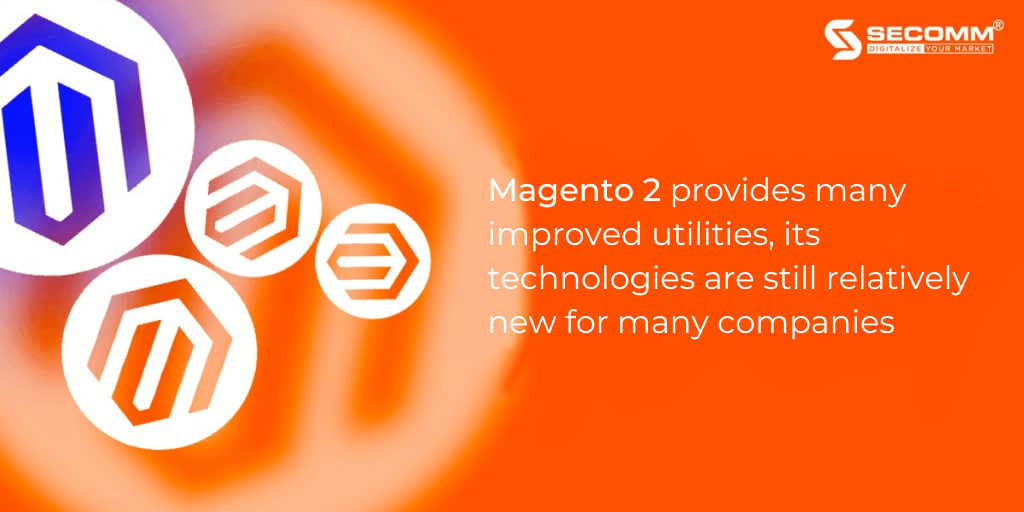
Upgrading from M1 to M2 is difficult because the technology infrastructure is entirely different between the two versions. As a result, website developers will require a significant amount of time to migrate all functions and data from M1 to M2, ranging from 1 to 3 months on average.
In addition, businesses require a technical team with expertise in new technologies to manage the system and efficiently upgrade the website. As a result, the upgrade costs more, ranging from $5,000 to $10,000 or more, depending on the system’s complexity.
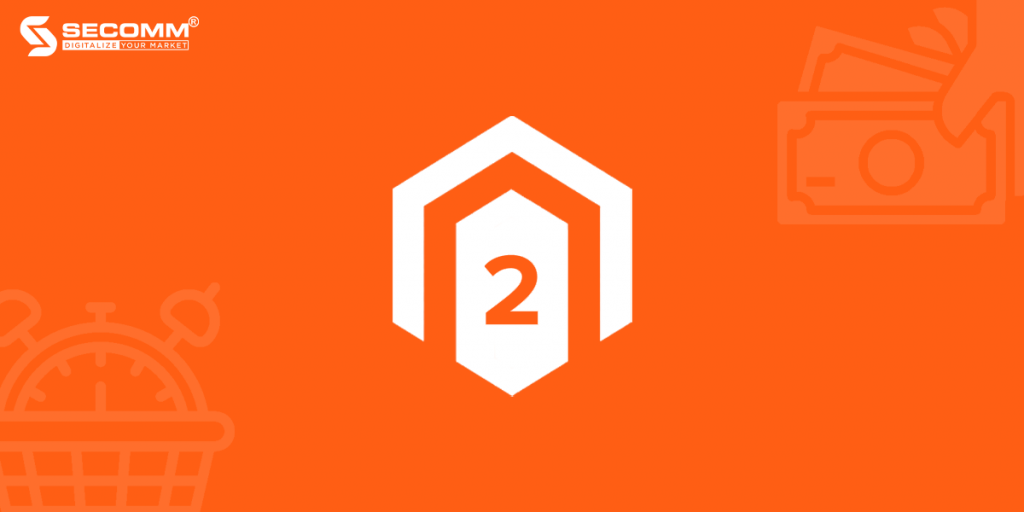
Although M2 outperforms M1 in every way, many businesses are hesitant to upgrade their websites to M2 due to various issues. However, upgrading the website to M2 is unavoidable in the long run due to the growing gap between the two versions.
Our company – SECOMM, has been partnering with many big enterprises such as An Nam Group (Vietnam), Jasnor (Australia), and Changi Airport Group (Singapore). As a result, we are aware of the challenges and worries firms face while developing an eCommerce website system as well as upgrading their websites from M1 to M2.
Get in touch with us now for FREE eCommerce development consultancy and solutions
 2
2
 4,146
4,146
 0
0
 1
1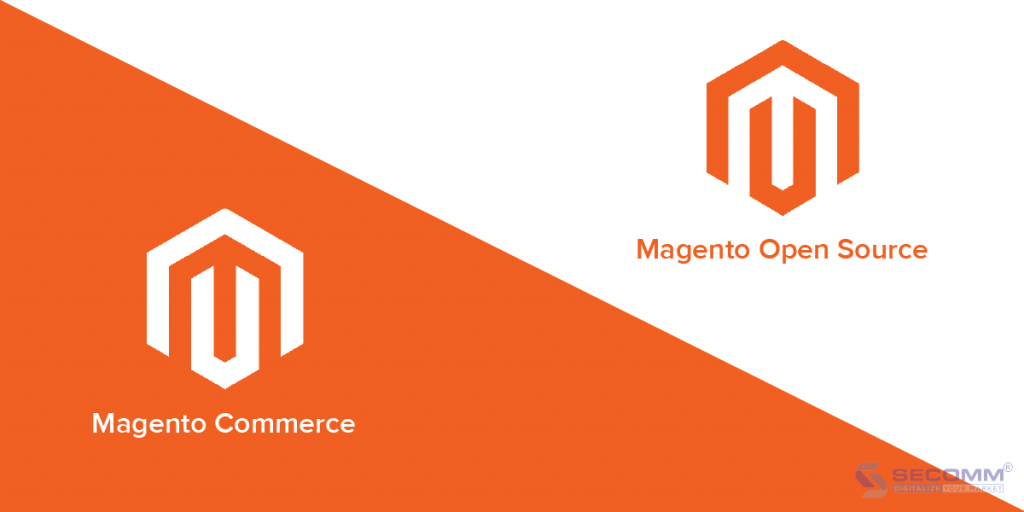
With over 200,000 websites worldwide, Magento is today’s most widely used eCommerce platform. Magento is always the best choice for businesses to use because of the benefits of open source code and specialized features for the eCommerce market.
Businesses must carefully study the strategy and consider the needs of the website system when deciding between Magento Open Source and Magento Commerce to implement eCommerce on the Magento platform.
Magento Open Source was initially known as Magento Community Edition (CE), a free version of the Magento open source platform. This version provides a flexible framework for building eCommerce websites, which is popular among many businesses.
.

Magento Commerce, formerly known as Magento Enterprise Edition (EE), is a website system used by large businesses with complex website system requirements.
This instance provides an on-premises solution as well as a hosted solution as a service (Magento Commerce Cloud), which aids in website performance and user experience. As a result, the annual fee for using this version is $24.000.

The platform will charge an additional $2.000/year for the included hosting service when using Magento Commerce to ensure that the business’s website system is constantly updated and upgraded, allowing it to handle high traffic and bills of lading more quickly.
Meanwhile, Magento Open Source is free to select a hosting provider that meets the business’s requirements and budget.
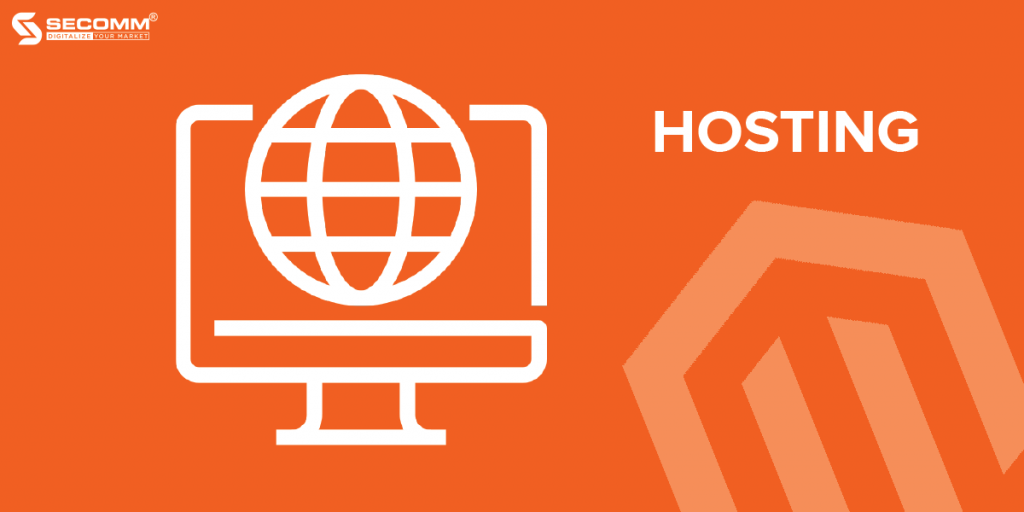
The following table compares the features that distinguish the two versions of Magento:
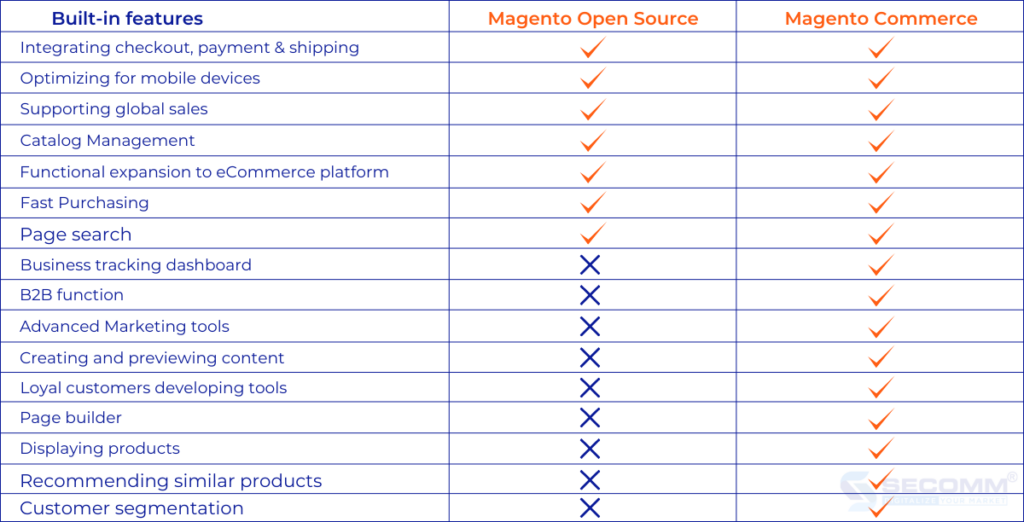
Magento Open Source has fewer features than Magento Commerce because it is a free version. Businesses, on the other hand, businesses can build the necessary functions themselves using extensions from the Magento ecosystem, the community of extension developers, or the project developers with whom Magento collaborates.
Magento Open Source will require a lower investment than Magento Commerce, from hosting and domains to website development. Nevertheless, the technology infrastructure is the same, so the costs of interfaces and extensions are calculated similarly.
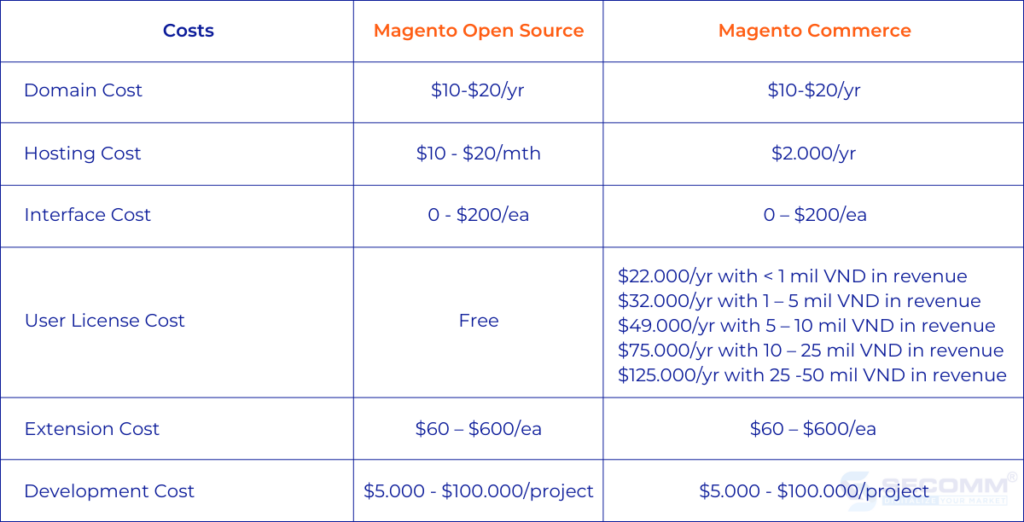
While Magento Commerce provides global technical support, including cloud service integration, Magento Open Source is not directly supported by the Magento technical team. However, the current Magento Open Source website developers continue to ensure expertise so that the business website is constantly updated and effectively operated.
Magento Open Source will be ideal for startups, SMEs (small and medium enterprises), businesses new to eCommerce, and even large corporations that do not yet require Magento Commerce’s advanced functionality system. Because using Magento Open Source is advantageous:
Meanwhile, Magento Commerce will be appropriate for large businesses because:

Choosing the best Magento version will be determined by each company’s long-term eCommerce strategy. However, it is also critical to implement those versions. They must collaborate with professional Magento developers to consult on and implement the best eCommerce solution.
With in-depth experience and developing many complex eCommerce systems on Magento, SECOMM understands the obstacles in choosing a platform and implementing Ecommerce businesses face.
Get in touch with us now for FREE eCommerce development consultancy and solutions
 2
2
 7,559
7,559
 0
0
 1
1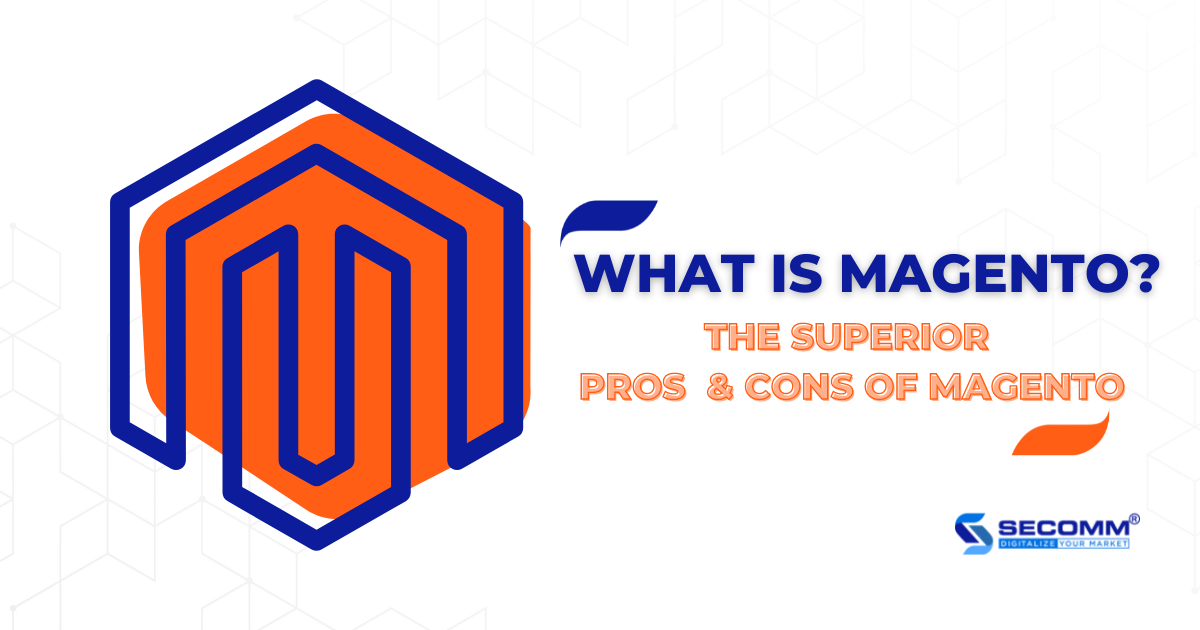
Along with the eCommerce market growth comes an increase in business demand for a separate eCommerce website system to maximize online business.
The platform’s role in developing and operating an effective eCommerce website system is enormous because choosing the right platform will help businesses save time in building a team, saving system development costs, reaching potential customers, boosting sales, and seizing long-term sustainable development opportunities.
Among today’s popular platforms such as Shopify, BigCommerce, WooCommerce, and others, Magento is widely regarded as the best platform for developing eCommerce websites, with over 186,000 websites in use worldwide.
This is an open-source platform designed specifically for the eCommerce industry. In addition, it is the most challenging source code platform in the PHP programming language. As a result, Magento can handle a company’s specialized needs in a constantly changing and evolving market like eCommerce.
Many major brands and corporations, including HP, Asus, Puma, and Walmart, have used the platform. In addition, some famous brands in Vietnam use Magento websites, including CellphoneS, Vua Nem, Kids Plaza, Mobile Viet, and so on.
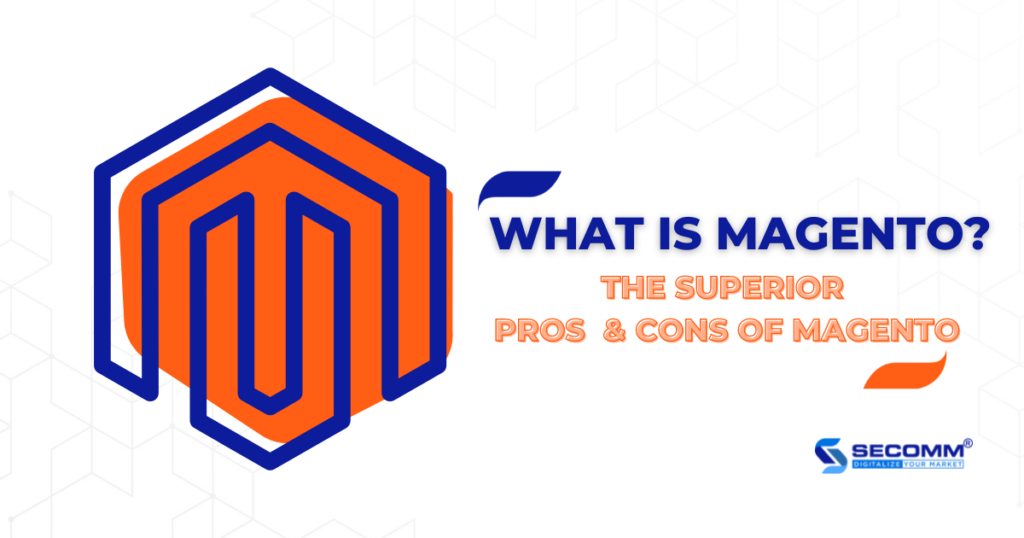
Magento currently offers two versions: Magento Open Source and Magento Commerce.
Magento Open Source was initially called Magento Community Edition, a free version of Magento. This version provides a “framework” to build eCommerce websites flexibly, so it is very popular with many businesses.
Some websites use Magento Open Source in Vietnam, such as Canifa, Kids Plaza, Bach Long Mobile, etc.

Magento Commerce was previously known as Magento Enterprise Edition. This version is appropriate for significant businesses that require a website system with complex functions.
In addition, this edition provides an on-premises or a hosted solution as a service (Magento Commerce Cloud), which aids in website performance. The minimum fee for using this version is $24,000 per year.
The brands using Magento Commerce in Vietnam are CGV, Bibo Mart, Rohto, etc.

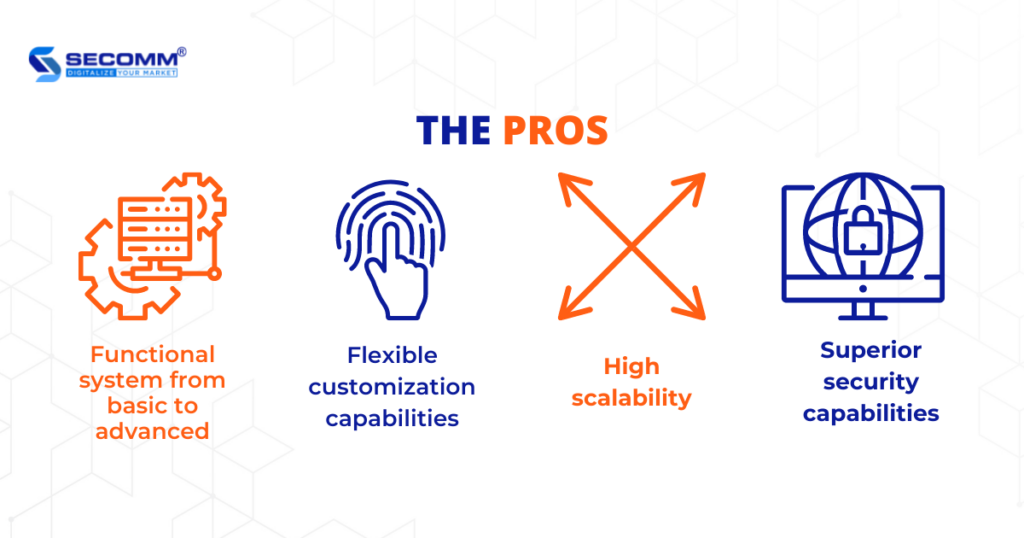
Magento includes all of the features required for a complete eCommerce website, including category management, content management, sales management, marketing management, and customer management, as well as analysis and reporting.
In addition, Magento owns many extensions with advanced features such as Headless Commerce, PWA (Progressive Web Apps), MSI (Multi-Source Inventory), ElasticSearch, etc to meet all eCommerce needs for businesses.
Furthermore, Magento has a global technical support community comprised of many experienced experts and professional development units to assist with meeting all business requirements.
Magento possesses all the advantages of an open-source platform with flexible customization capabilities. Owning and controlling the entire source code, in particular, allows businesses to customize parts of the code in the system, easily update, or even develop new functions based on each business specificity.
In addition to customizing, Magento also has very useful website scalability. Magento allows businesses to scale from one website to many websites, one store to many stores, but the management is still on the same system. Besides, Magento supports multi-language and currency conversion, helping businesses expand globally.
Magento’s high security is also an outstanding advantage, with the ability to control the system regularly, propose security solutions, improve security for administrators, and prevent bots or unauthorized malware, among other things. As a result, this platform assists businesses in reducing potential risks associated with the data and transaction processes.
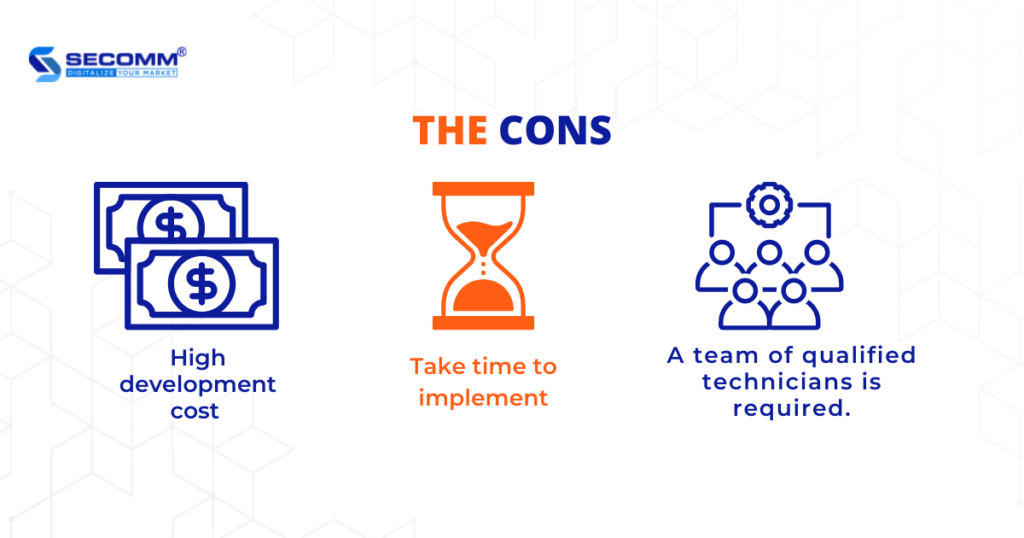
The cost of owning a Magento website is high due to its many outstanding benefits, such as the functional system, customizability, scalability, and good security. However, depending on the system’s complexity, a website built on the Magento platform costs between $10.000 and $100.000.
A comprehensive Magento project requires implementation time ranging from 3 months to 1 year. A complete Magento project requires implementation time ranging from 3 months to 1 year. As a result, it slows down businesses’ digital transformation processes and makes it difficult for them to keep up with competitors’ development rates and market trends.
Businesses require a technical team with high expertise and experience with the Magento platform to build and operate an intensive eCommerce website system customized to the unique characteristics of each product and category.
As a whole, Magento is an eCommerce platform that is appropriate for all types of businesses, including startups, SMEs (small and medium enterprises), and large corporations. However, budget, time, and professional team issues have caused many SMEs businesses to be hesitant to use Magento to develop eCommerce websites. That is why Magento frequently be used in large corporations to build complex eCommerce systems.
Our company – SECOMM, has been partnering with many big enterprises such as An Nam Group (Vietnam), Jasnor (Australia), and Changi Airport Group (Singapore). As a result, we are aware of the challenges and worries firms face while developing an eCommerce website system.
Contact SECOMM now for a free consultation on detailed eCommerce system development solutions!
 2
2
 5,015
5,015
 0
0
 1
1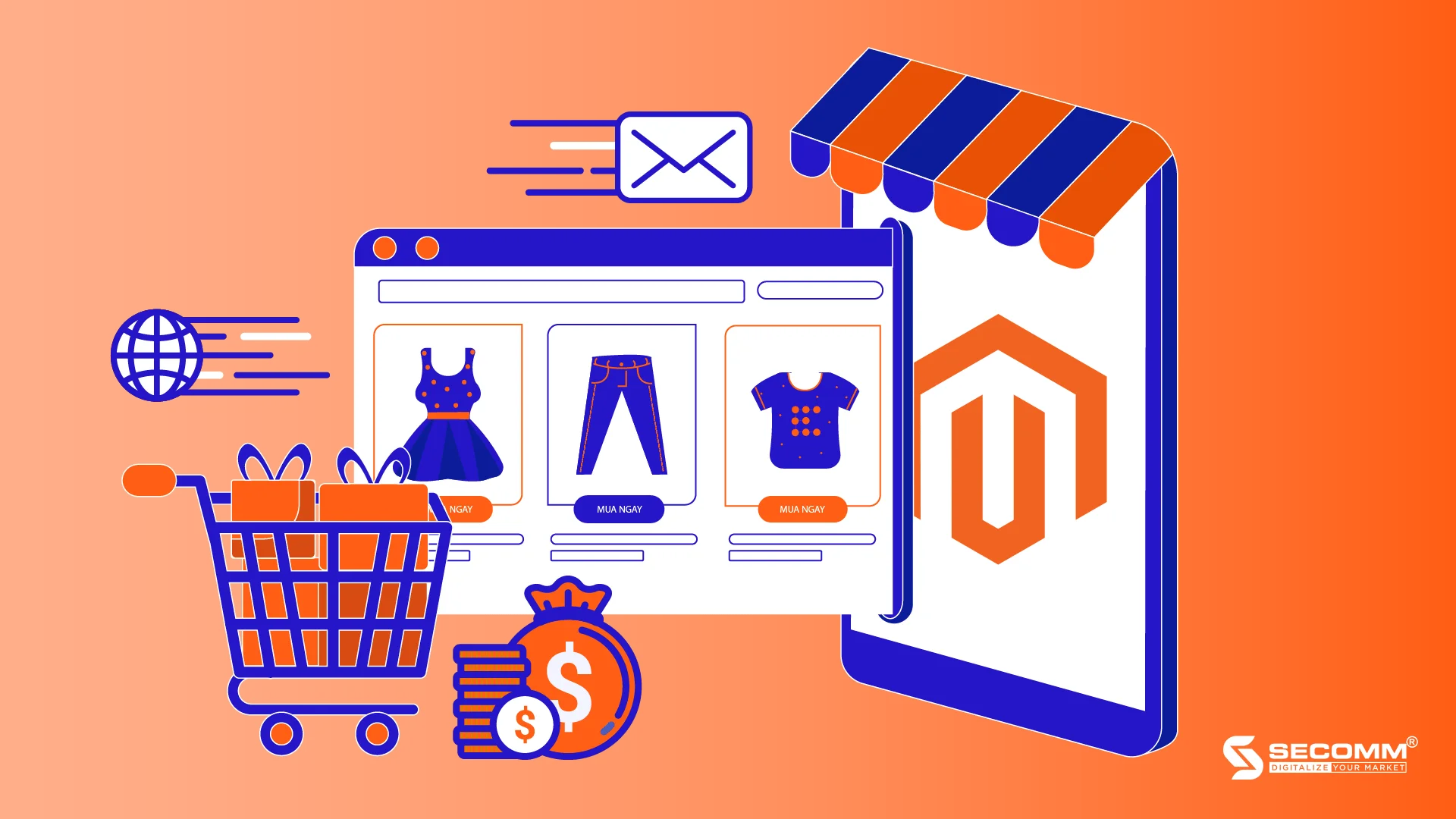
When deploying an ecommerce website, Magento is the top choice of platform that businesses are aiming for, including global giants like Nike, ASUS, HP, and Burger King, as well as leading Vietnamese enterprises such as Canifa, CellphoneS, Trung Nguyen, and CGV Vietnam.
With outstanding advantages ranging from a diverse ecosystem and flexible customisation capabilities to absolute security, Magento is considered the ‘ultimate boss’ among ecommerce website development platforms today.
So, what are the superior points of Magento?
Magento possesses all the features for a complete ecommerce website:
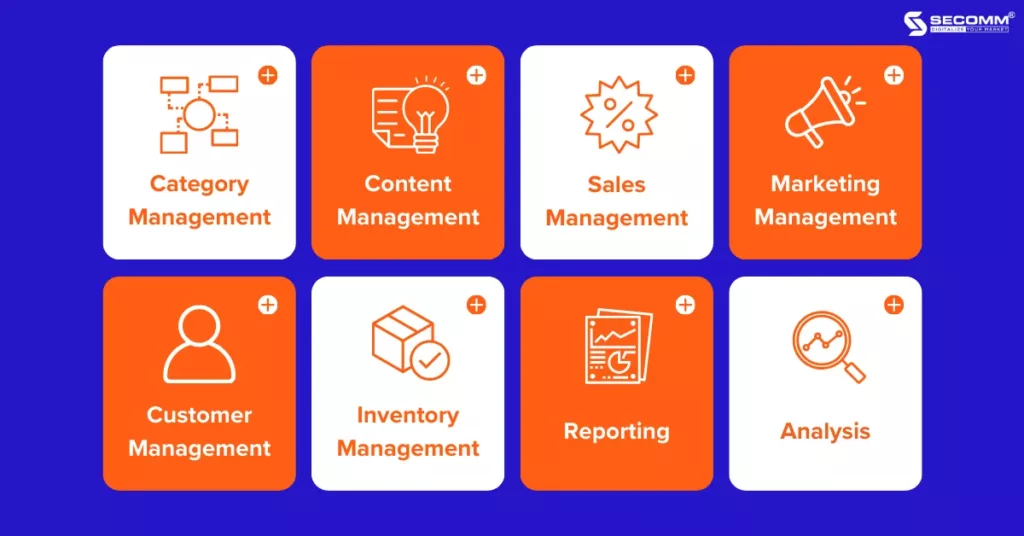
In addition to the basic features of a complete ecommerce website, Magento also owns a diverse system of extensions with many advanced functions in themes, products, marketing, optimal payment solutions, shipping, etc. to meet every operational need and ensure sustainable development of ecommerce for businesses.
When building an ecommerce website, Magento also supports businesses to integrate and link third-party services for efficient ecommerce website operation, such as:
Furthermore, Magento also has a global technical support community, including many rich experts and professional developers to meet all the requirements of businesses.
The Magento ecommerce website platform possesses all the advantages of open-source software with flexible customisation capabilities to operate the ecommerce website more effectively.
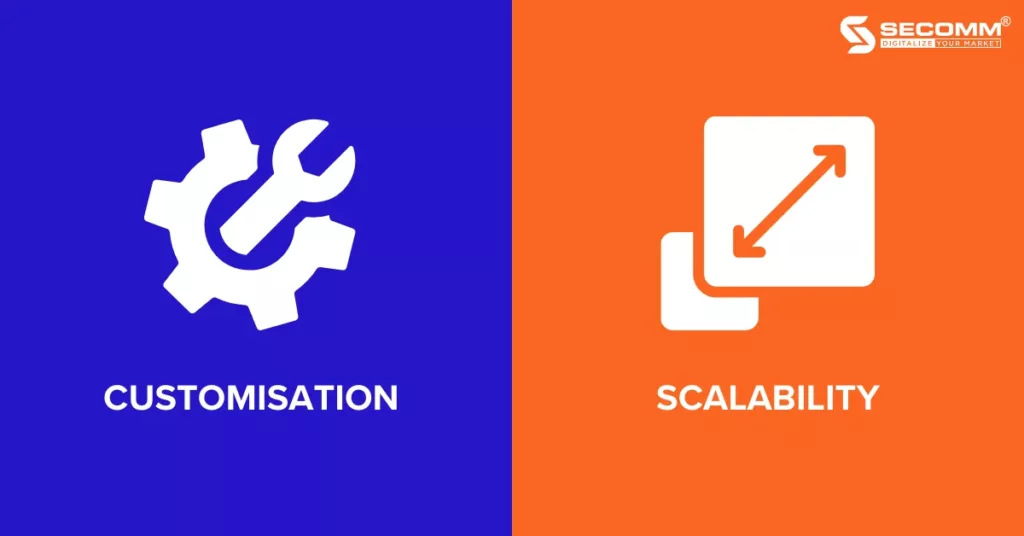
High security is also a superior advantage of Magento compared to other ecommerce website platforms, helping businesses minimise potential risks from data systems and transaction processes on the system.
Some outstanding points of Magento’s security features include:

With the advantages of having all ecommerce website functions, from basic to advanced, high customisation capabilities, and high security, Magento is the top choice for businesses when deploying an ecommerce website system. However, issues related to costs, time, and the requirement for a highly specialised technical team make it challenging for many businesses to implement an ecommerce website system with Magento.
Contact SECOMM now for FREE CONSULTATION SUPPORT!
 2
2
 3,869
3,869
 0
0
 1
1
Faced with various market influences, the demand for developing eCommerce systems among businesses in Vietnam is gradually becoming more defined and undergoing a stronger transformation. The Covid-19 crisis, in particular, has been a significant catalyst accelerating this transformation process rapidly.
So, how should businesses chart their journey in developing an eCommerce system to not only adapt to market and customer changes but also seize opportunities and excel in this highly competitive arena?
In general, the development journey of eCommerce systems for Vietnamese businesses, from the initiation of business to expanding the scale with a specialized eCommerce system, typically goes through three important milestones.
Businesses need to thoroughly understand these milestones and coordinate with a detailed examination of goals, budgets, and the current state of the business to devise an appropriate and tailored development journey.
The emergence of the eCommerce marketplace has efficiently addressed the online buying and selling needs not only for small online shops, startup businesses, and small to medium-sized enterprises but also for large brands.
With an extensive operational system, eCommerce marketplaces create many favourable opportunities for businesses and individual small-scale entrepreneurs with budget constraints. By only incurring basic expenses for setting up a storefront and annual maintenance fees, businesses and store owners can quickly have their shops.
Additionally, processes such as payment, shipping, customer care, post-delivery issue resolution, and marketing programs are simplified with comprehensive support from eCommerce marketplaces. Choosing an eCommerce marketplace to initiate business is a suitable start, helping businesses increase brand coverage, competitive ability, and sales volume at cost savings.
Even large brands/brands that have developed offline are currently utilizing eCommerce marketplaces to penetrate and expand the market. For developed brands and traditional businesses looking to transition to online business, eCommerce marketplaces are the right starting point to test eCommerce business.
From there, businesses can build a comprehensive eCommerce development strategy, from eCommerce marketplace to social commerce, brand.com website development, and implementing an omnichannel approach.
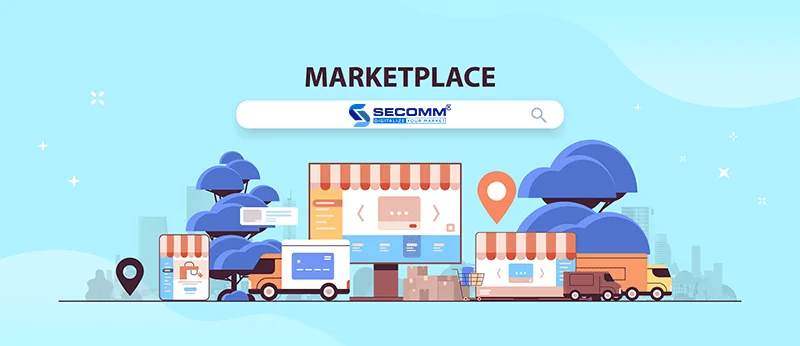
In Vietnam, popular eCommerce marketplaces such as Shopee, Lazada, Tiki, Sendo, etc., are favoured by many businesses. With a massive monthly user base and attractive promotion programs, diverse service systems, eCommerce marketplaces maximize support for sellers in swiftly bringing their brands and products to the market through simple steps:
Despite the significant benefits of doing business on eCommerce marketplaces, businesses and individuals are subject to substantial dependence on policy and operational changes. They also face limitations in accessing and leveraging potential customer data to improve marketing efficiency or personalize the customer experience. Furthermore, businesses must directly compete with a large number of similar stores and brands on the platform regarding pricing and product quality.
In addition to doing business on eCommerce marketplaces, businesses can independently develop a basic eCommerce system, getting closer to potential customers and implementing their own eCommerce Marketing programs.
Developing a basic eCommerce system does not require excessive investment in time, development costs, or website programming. Businesses only need to use free website-building tools with available interfaces and features to easily create a website through simple drag-and-drop operations.
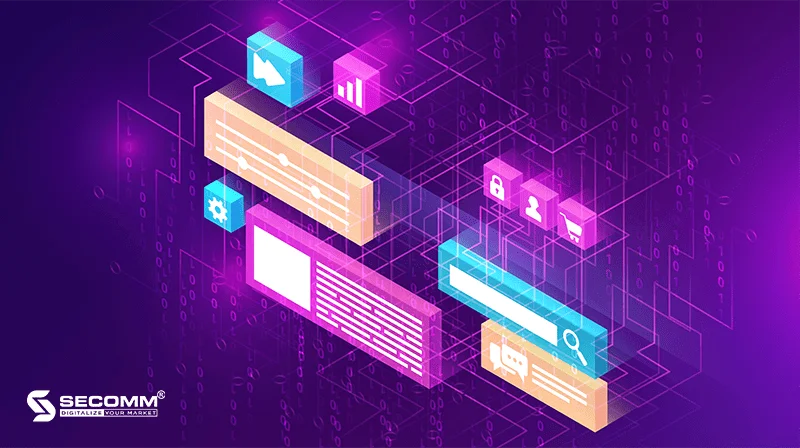
Some popular website building tools in the current Vietnamese market that support the development of a simple eCommerce system include Sapo, Haravan, and Nhanh.vn.
Based on criteria such as simplicity, availability, time and cost savings, most of these tools will meet the basic needs of developing an eCommerce system. However, available website design tools also pose several challenges, limiting business operations and eCommerce expansion:
Typically, after a period of doing business on eCommerce platforms or using available website design tools, businesses gradually recognize the need to develop a specialized eCommerce system designed to propel a sustainable eCommerce journey.
Developing a specialized eCommerce system requires both experience and substantial investment in terms of costs and deployment time. However, this approach proves to be a cost-effective solution for the long-term business plans of companies, delivering sustainable business efficiency, and serving as a perfect transition for an independent and comprehensive eCommerce system.
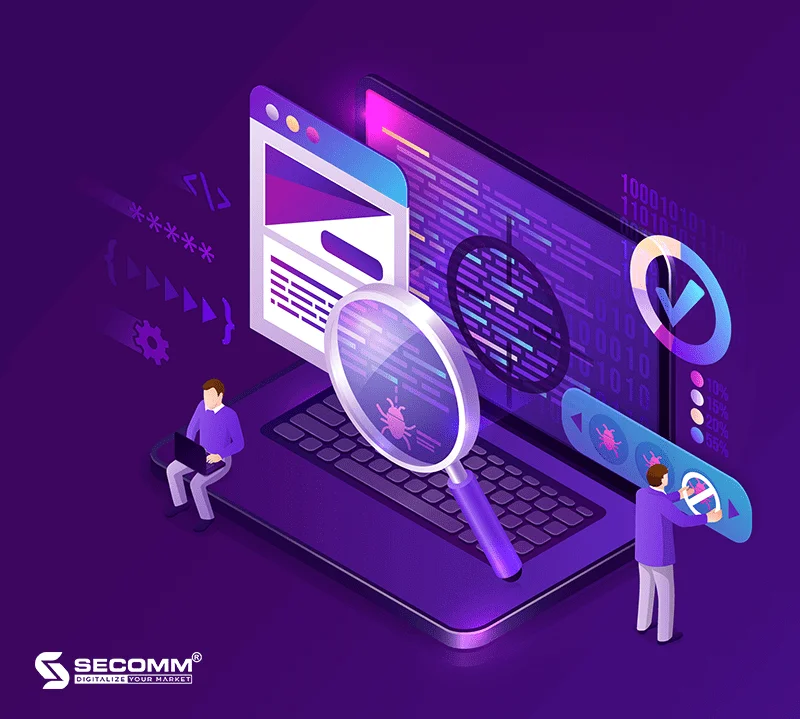
Developing a specialized eCommerce system will maximize meeting various needs, such as:
Among the specialized eCommerce platforms widely used by businesses today, such as Shopify, BigCommerce, and WooCommerce, Magento stands out with significant advantages and caters to all business needs from simple to complex. Many multinational corporations currently leverage Magento to build sophisticated eCommerce systems, including names like Samsung, Nike, Coca-Cola, Lenovo, Olympus, Port, Pox, Nestle, BevMo, Burger King, and Murad, among others. Additionally, millions of small and medium-sized eCommerce sites worldwide are also built on this platform.
With all the outstanding advantages of a specialized eCommerce platform, Magento is undoubtedly a suitable choice for both B2B and B2C businesses, catering to businesses of all sizes, from startups to large enterprises.
Contact SECOMM for a detailed consultation on the comprehensive and sustainable development journey of your eCommerce system for businesses.
Also, explore Magento solutions tailored specifically for SMEs in Vietnam!
 2
2
 6,831
6,831
 0
0
 1
1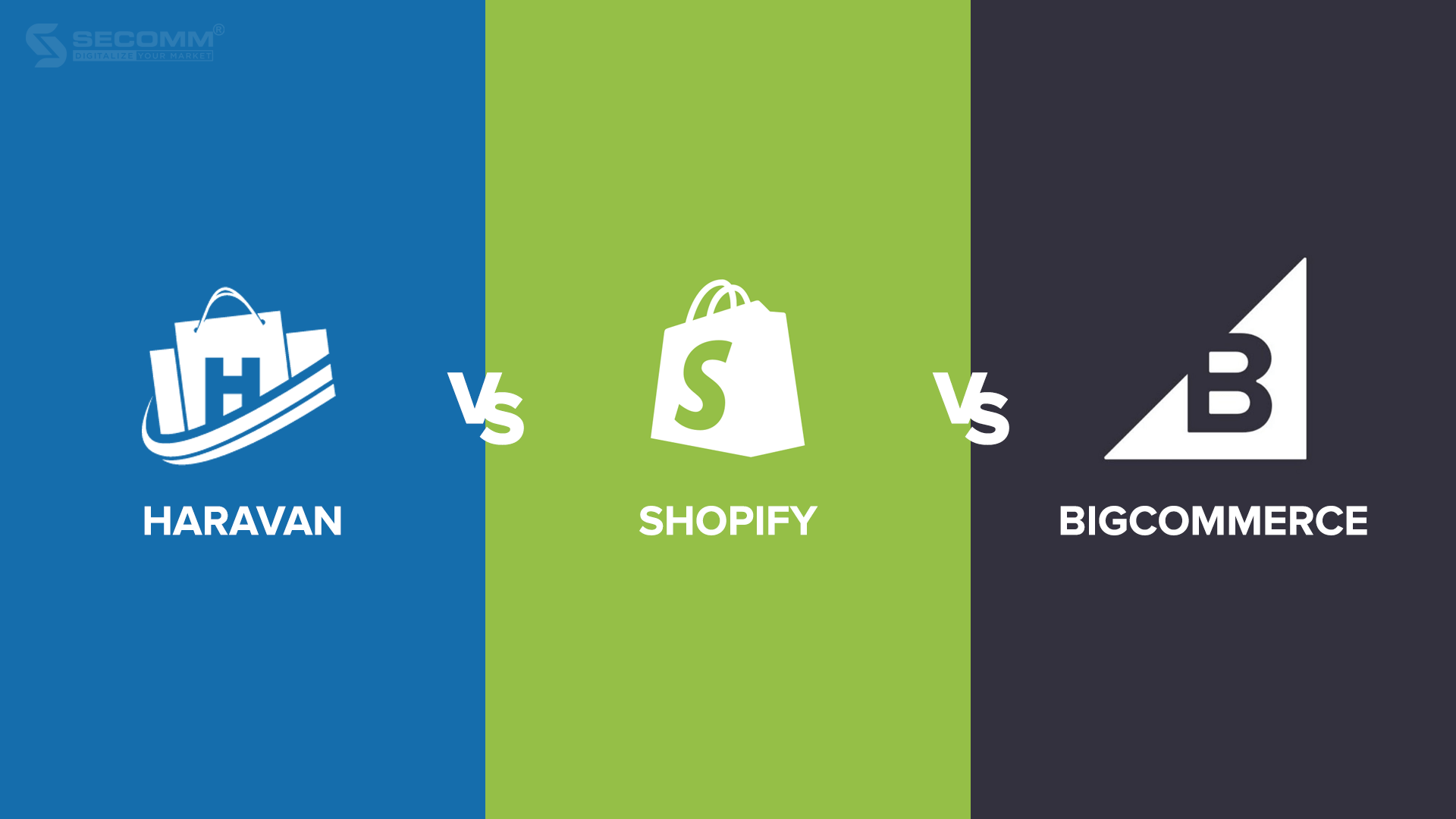
Many firms have selected SaaS eCommerce platforms to create e-commerce enterprises for brands because of their essential qualities, which can rapidly install eCommerce at a low cost.
In Vietnam, Haravan is the most popular eCommerce platform that allows multi-channel sales. This platform was officially launched in 2014, aims to assist companies in developing professional e-commerce websites at an affordable cost.
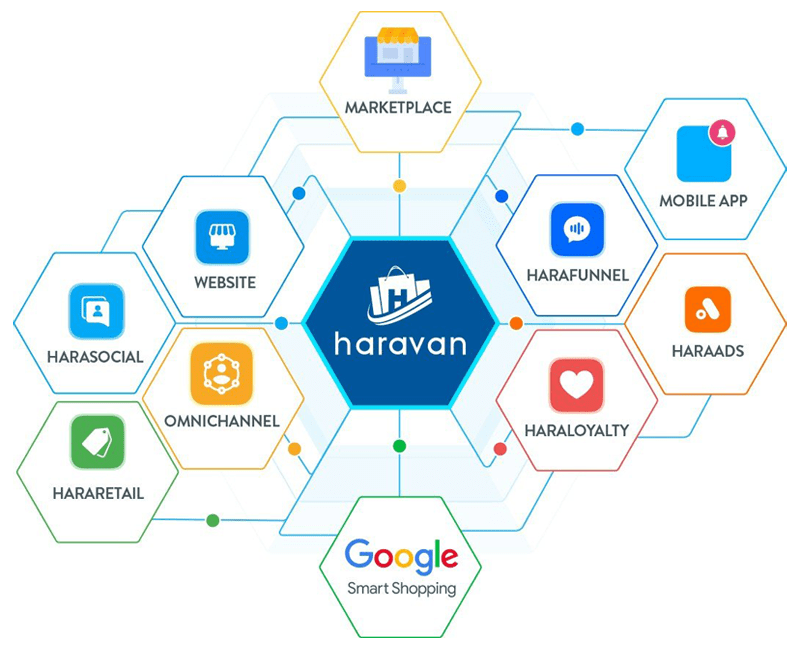
Haravan provides many UI/UX themes so that firms may select a design that suits the brand’s image. At the same time, many organizations regard the admin interface to be easy to use. However, companies must pay additional fees to raise the number of admin accounts.
Haravan’s essential features, on the other hand, are just enough for businesses to run their web operations successfully but not ideal sufficient for long-term development. In addition, because Haravan is a SaaS platform, organizations find it difficult to customize or expand functionality outside of its ecosystem.
Haravan’s drag-and-drop manipulation allows companies to create an eCommerce website with all the critical functionality for business online in around 30 minutes.
Businesses must pay a monthly charge ranging from 200,000 VND to 3,000,000 VND based on their demands:
Haravan is now gaining popularity in the Vietnamese eCommerce business, particularly in the B2C model or low-involvement product business, due to its ability to deploy with affordable charges swiftly. Vinamilk, Juno, and L’Oréal are some companies that use Haravan.
Shopify is a software-as-a-service platform for online retailers and point-of-sale systems. Shopify is popular among the eCommerce community due to its simplicity, quick development timelines, and low setup expenses.

Shopify provides many attractive themes that are device-agnostic and ideal for a broad array of industries. Shopify’s admin dashboard is simple to use, and it offers a Vietnamese version for Vietnamese firms. Like Haravan, firms must upgrade their service packs to expand the number of admin accounts.
Depending on the system’s complexity, each business will need some time to get used to Shopify. Still, in general, it will not take long for companies to establish a website, taking between 1 and 2 days on average.
Shopify has created a variety of packs for companies to choose from:
Shopify also creates different service bundles to meet a range of organizations:
Shopify is constantly developing and enhancing its offerings to meet a wide range of customer requests rapidly and effectively, making it perfect for B2C enterprises. However, the monthly cost is a significant impediment because firms must pay significantly more to use extra functions. Sony Vietnam, Vsmart, and DHC Vietnam are some Vietnamese companies that use Shopify.
BigCommerce is a SaaS platform that launched in 2009 and has made a significant impact on the eCommerce developer community. Despite being founded later than other platforms, BigCommerce does not fall behind in terms of a functional system, theme store, and so all.
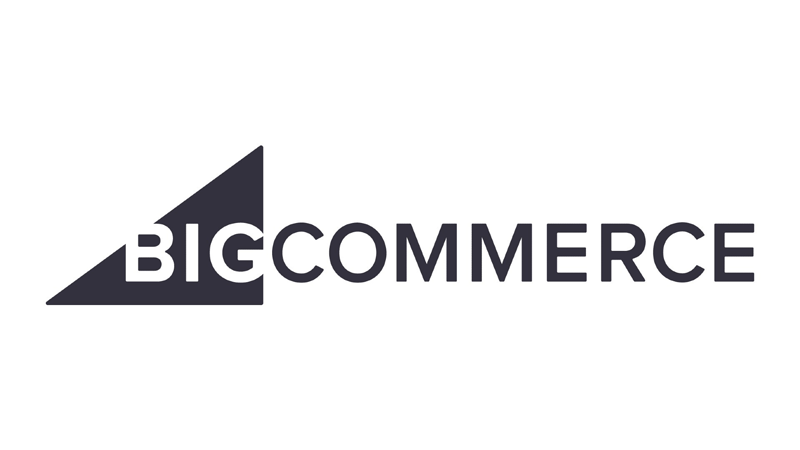
BigCommerce provides a wide range of visually appealing themes and adapts to customer behavior, including 12 free versions and over 160 professional ones. BigCommerce’s admin dashboard is easy to use, and it supports businesses in rapidly setting up eCommerce websites. However, since BigCommerce does not offer a Vietnamese version, firms must hire and train English-qualified employees to manage the site.
BigCommerce’ packages are jam-packed with features and add-ons to help businesses achieve solid internet business. However, BigCommerce’s capacity to customize and expand functionalities remains limited, restricting firms from adapting to their needs to deal with industry-specific difficulties.
Thanks to its drag-and-drop page builder feature, the time it takes to establish a website on BigCommerce is shortish. BigCommerce construction process takes about 1-2 days on average.
BigCommerce now supports three package options and one on-demand solution:
Moreover, BigCommerce will charge you additional fees based on your online sales.
Overall, BigCommerce is not inferior to Haravan or Shopify in every way; nevertheless, the central issue right now is that this platform does not support Vietnamese enterprises.
Inheriting the advantages of a SaaS eCommerce platform, all three platforms are easy to use, with various themes and functions for quick construction at a reasonable cost.
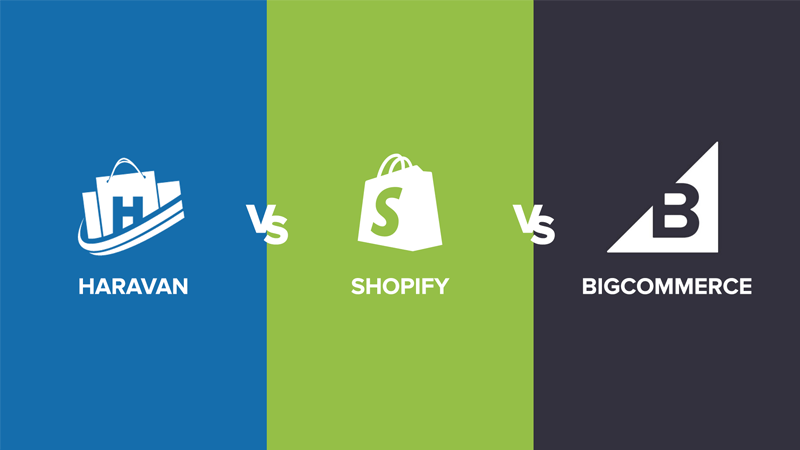
Businesses that solely conduct business in Vietnam may choose to use Haravan to take advantage of cost-competitive benefits and functionalities tailored to suit Vietnamese shopping habits. Shopify and BigCommerce are options to explore if you want to develop your business worldwide. Simultaneously, Shopify is ranked higher for providing great 24/7 live chat support, which will aid companies in addressing difficulties as quickly as possible. As a consequence, Shopify will be ideal for large-scale and high-volume enterprises. BigCommerce, on the other hand, compresses functionality into more affordable solutions and is not restricted to the number of administrators like Shopify, making it suitable for small or medium-sized businesses.
However, using SaaS eCommerce platforms like Haravan, Shopify, and BigCommerce in the long term would result in the following deficiencies:
SECOMM has significant experience developing complicated eCommerce websites in different countries, and we know the challenges that businesses face when selecting and implementing an e-commerce platform.
Contact SECOMM for a free consultation on eCommerce website development!
 2
2
 7,209
7,209
 0
0
 2
2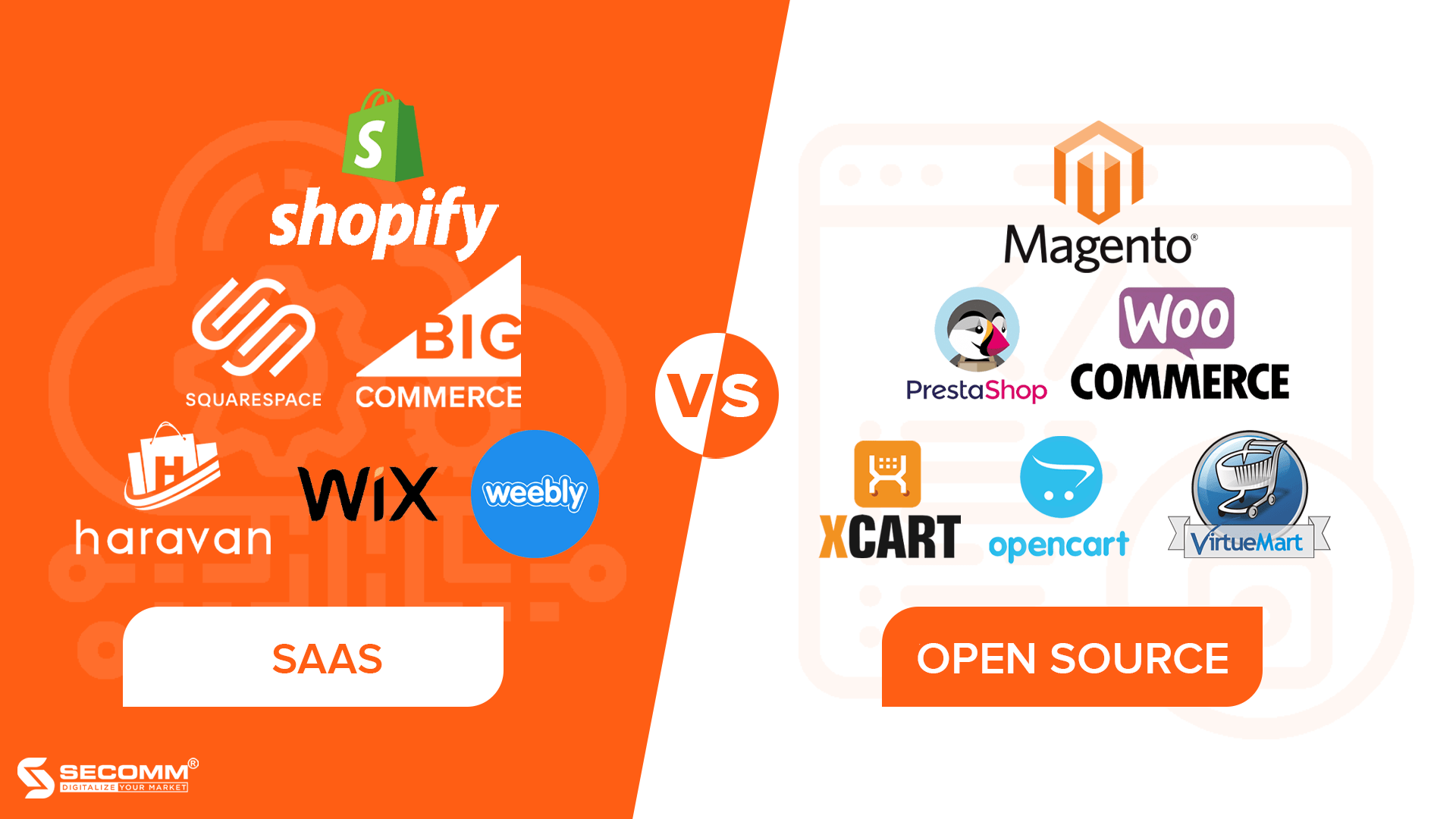
A SaaS eCommerce Platform is a service delivery paradigm for developing a software-based website system. Data is kept on the provider’s server system under this approach, and that platform is in charge of dealing with technical concerns for the business.
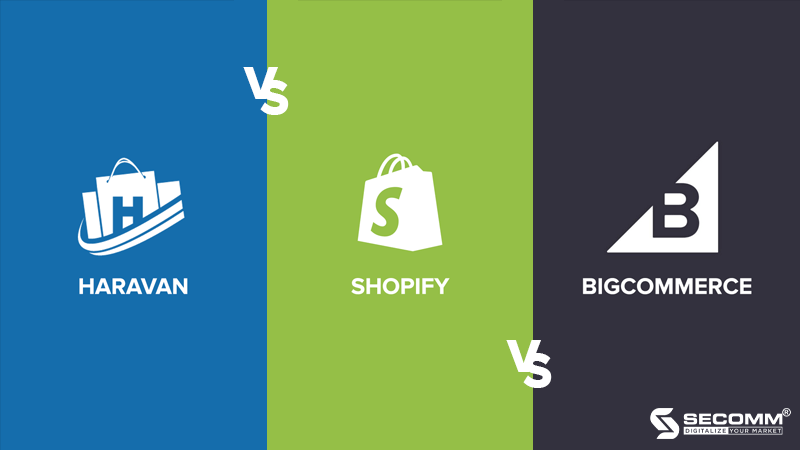
The provider pre-designs the SaaS platform for the full system, from hosting, interface, and features to technological infrastructure maintenance. As a result, organizations can quickly create and manage a website system without worrying about technological concerns.
Furthermore, the platform developer offers firms 24/7 assistance through live chat, desk help, or a hotline while the platform is in operation.
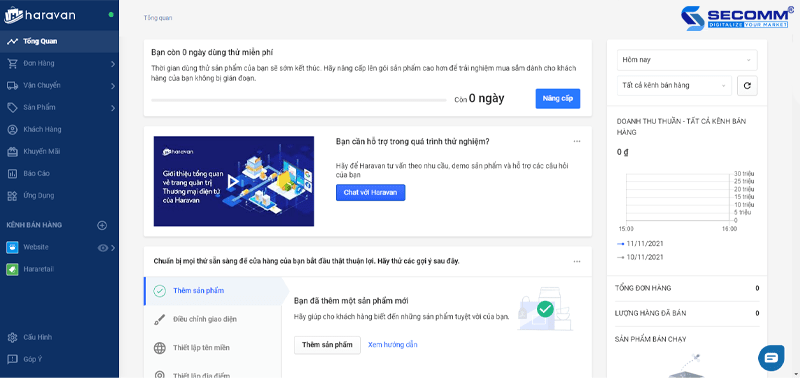
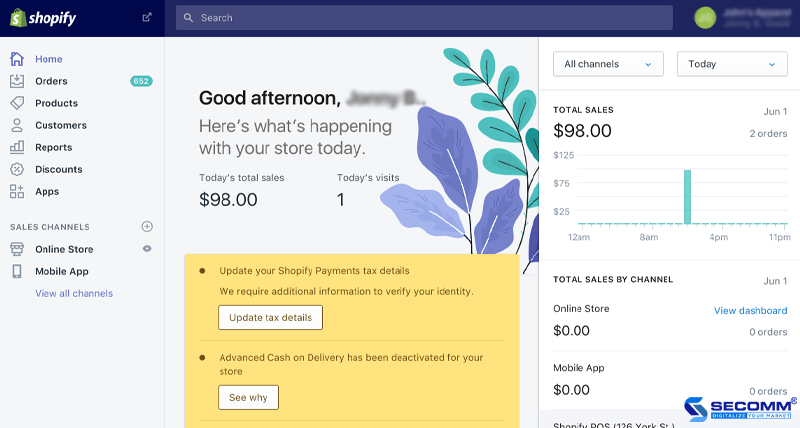
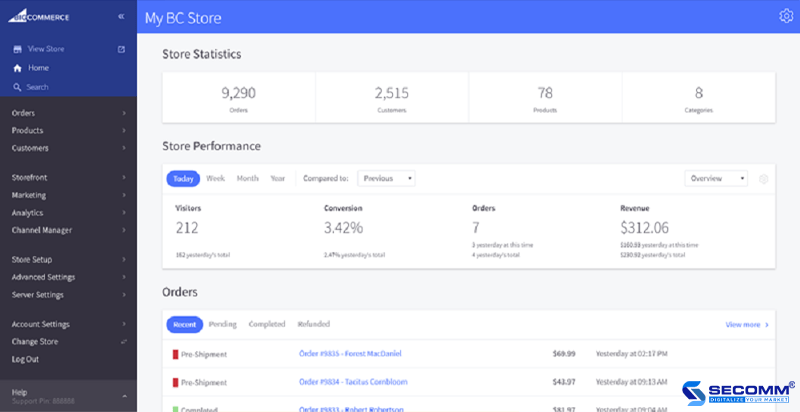
The SaaS eCommerce Platform includes a multitude of functionality and appealing UX/UI interfaces, making it suitable for a variety of businesses.
Furthermore, these platforms include a wide range of essential eCommerce functions, including product administration, order management, customer management, marketing, business analysis, and reporting to let firms quickly develop an e-commerce website. Moreover, extensions such as Omni-channel, Affiliate Marketing, E-Payment, E-Logistic, and so on are constantly added to these platforms to strengthen the e-commerce system.
The time it takes to establish a website on a SaaS eCommerce Platform is quite fast, ranging from 1 to 7 days on average, depending on the website’s setup.
The initial building cost is pretty cheap because firms would pay monthly or yearly use fees (subscription-based) to establish a website using SaaS eCommerce Platforms, such as:
Aside from the monthly/yearly licensing charge, businesses must pay extra expenditures such as interface fees, new features, expanding the number of backend users, and POS (Point of Sale) to grow the eCommerce system.
Because the enterprise’s whole website system is housed on the provider’s server, ownership and control of the website source code will belong to that platform, not the firm. Businesses who transfer platforms can no longer utilize the previous site source code and must rebuild from scratch on the new platform. Moreover, data loss or misalignment is usually unavoidable.
The enterprise’s data, like the source code, is likewise kept on the provider’s server, thus ownership and control over the data remains constrained. There are many difficulties for not owning and controlling data, such as linking data between departments, customizing users, and so on.
Because the website system depends on the SaaS platform, customization and expansion are currently limited. When it comes to upgrading existing features, developing new functions for the company’s development, in line with the particular requirements of the product and industry, and optimizing the user experience, SaaS platforms are frequently unable to adapt. As a result, switching platforms after a period of usage is unavoidable, and of course, this change will take significant time and money for the company.
Because you must pay monthly or yearly license fees, the longer you use the higher the overall cost of use. Furthermore, the SaaS eCommerce Platform charges on the revenue online sales.
For example, various Shopify apps, such as DCart (Create Discount Codes on Cart), OctaneAI (Similar Product Suggestions), Ali Reviews (Product Reviews), and others, would charge a monthly fee, average $10 /month/features. The more applications that are installed, the more the monthly or yearly expenses will be.
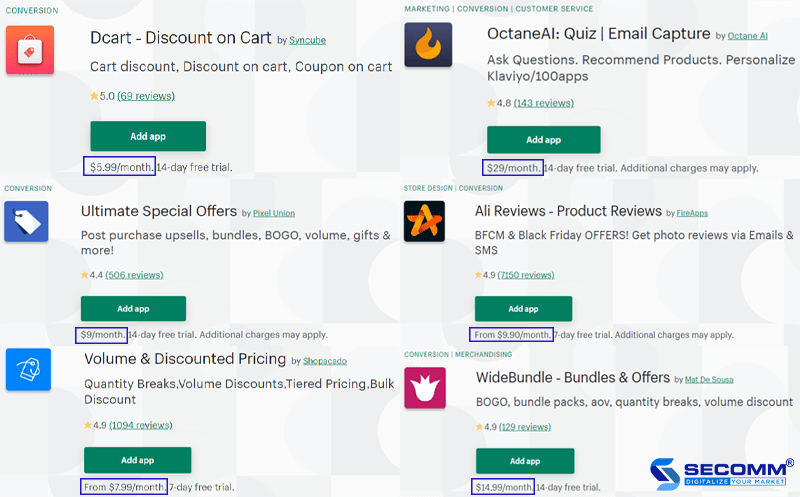
Businesses can use the SaaS platform if they wish to enter the e-commerce industry rapidly, have minimal need for customization, and do not need to enhance the system. As a result, SaaS systems are frequently selected by startups, SMEs (small and medium enterprises), and businesses just getting started in the e-commerce industry.
Open Source is software whose source code is publicly available and freely used by anyone.
Because the data and source code will be housed on a separate server system, Open Source eCommerce Platforms have the opposite aspects of SaaS platforms. Businesses that use open source platforms must collaborate with professional website developers or build a highly specialized in-house team for the website system to achieve maximum efficiency.
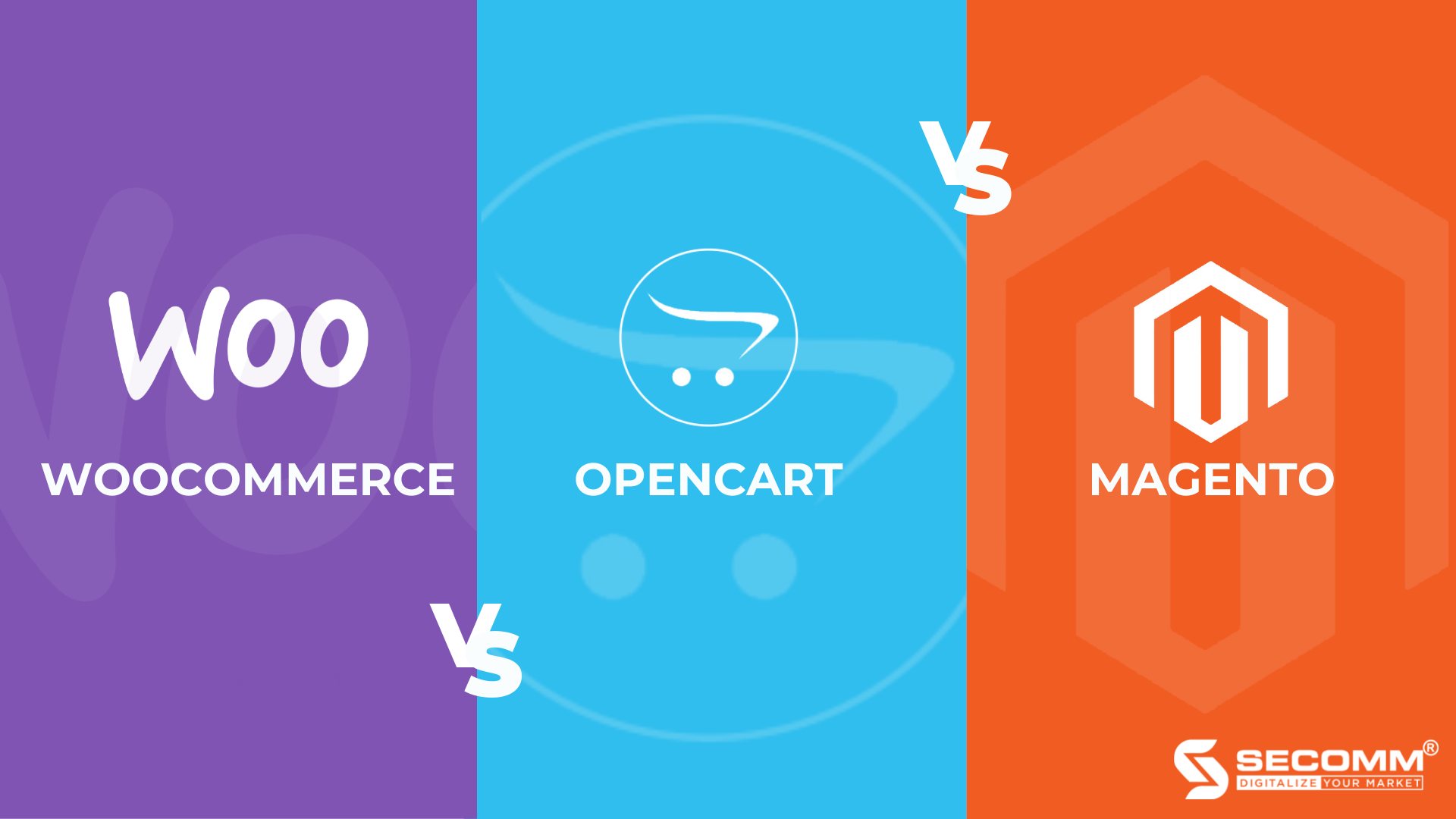
Businesses have complete ownership and control over the source code and data on the system due to the characteristic of being housed on a separate server system. As a consequence, while deploying an eCommerce website, companies only need to pay development expenses in order to utilize the source code, rather than monthly/yearly license fees just like SaaS platforms. At this point, you could reuse the previous source code if you change developers or platforms. Furthermore, security is improved, reducing hacker attacks, server failures, and technical faults from staff and consumers.
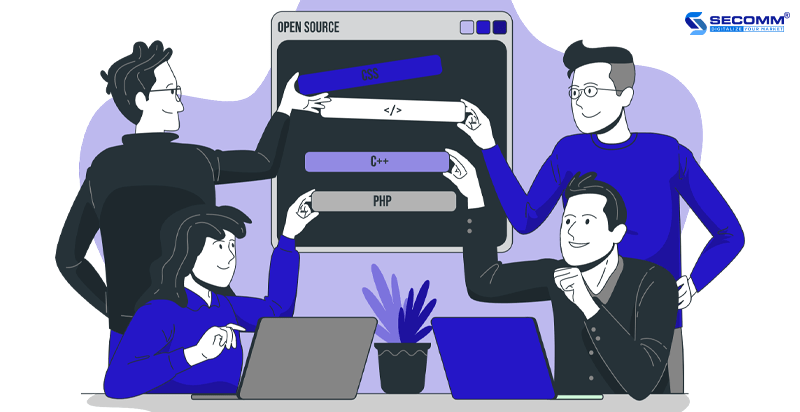
Businesses have more choices in developing their website’s interface to boost brand image and maximize revenue since they use Open Source eCommerce Platforms.
Currently, there are three methods for designing interfaces:
In terms of website system features, Open Source eCommerce Platforms are quite superior to SaaS platforms. Not only have basic functions, but Open Source eCommerce Platforms also have many advanced features such as quick search, similar product suggestions, abandoned cart notifications, real-time products, and so on.
In addition, the Open Source eCommerce Platforms also has many add-ons that are improved, provided, and shared by the developer community.
Because organizations control their own source code, they can simply update the functional system, build new features, or expand the system to suit business demands and meet consumer needs. At the same time, the open-source code’s flexibility allows businesses to easily link with third-party utilities in order to run the system.
It is hard to build “tailor-made” systems for each firm with a system of various e-commerce features ranging from basic to complex, therefore systems developed on open source e-commerce platforms frequently have high accuracy. As a result, in order to build and function efficiently, a specialized team or development organization must have strong knowledge and several years of experience.
Deployment times for open source e-commerce platforms are frequently lengthier than those for SaaS platforms. Depending on the complexity of the functional system, the average amount of time for the IT team to build a website varies from 3 months to 1 year.
Using an open-source platform is basically free, but having a full e-commerce system from website to mobile app needs a significant commitment of your own labor. The in-house IT team will design interfaces and functions. As a result, the initial cost of developing an e-commerce website using an open-source platform is pretty expensive, an average of $10,000 per project.

The Open Source eCommerce Platform is suited for all sorts of enterprises due to its numerous features. However, budget and implementation time restrictions have kept many small and medium-sized businesses from utilizing it. Large firms frequently engage in these platforms to construct specialized and specialized eCommerce systems.
In general, the decision of which eCommerce platform to select will be determined by each firm’s business plan, budget, and time of eCommerce development.
 2
2
 7,315
7,315
 0
0
 1
1Subscribe to get the latest eBook!
Hotline